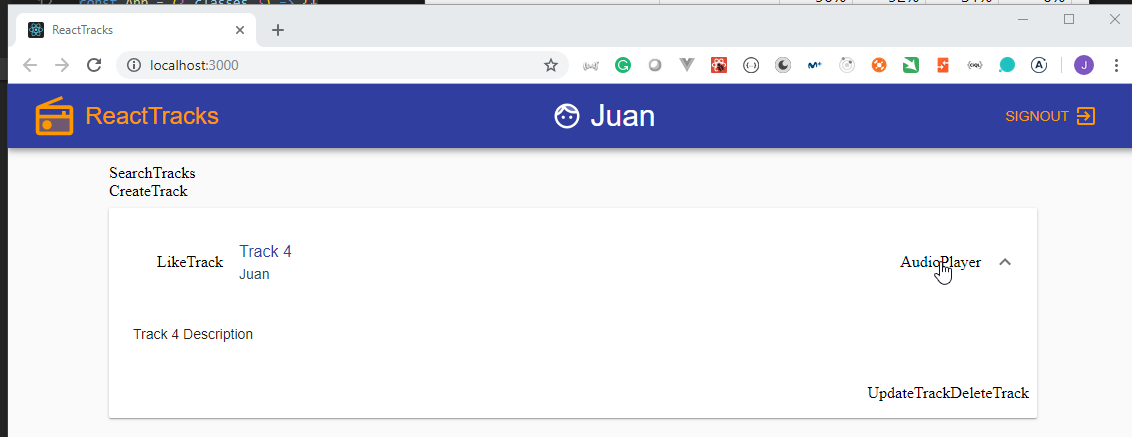Full-Stack React, Python, and GraphQL (Part 2)
Github Repositories
The Full-Stack React, Python, and GraphQL Udemy course helps develop impressive, rich full-stack apps with the latest and greatest features of Python, React and GraphQL.
Other parts:
Table of contents
- What I've learned
- Section 5 Developing a React Client App for the Backend 4hr 12min
- 29. Adding our React Client App 3min
- 30. Exploring the React Source Code 6min
- 31. Setting up Apollo Client / Executing Queries with React Apollo 5min
- 32. Enabling django-cors-headers for Connecting to our Backend 4min
- 33. Creating our Register Form 8min
- 34. Executing GraphQL Operations Client-Side with Apollo Dev Tools 4min
- 35. Storing Form State with useState 5min
- 36. Executing Mutations with Mutation Component / Register User Mutation 6min
- 37. Finishing Register (Success Dialog, Toggling Auth Components, Transitions) 13min
- 38. Custom Error Component / Improved Error Handling 6min
- 39. Build out Login Form / Execute Login Mutation for JWT 7min
- 40. Using Apollo Client State to Manage Auth State 9min
- 41. Adding JWT to our Authorization Header with Apollo Client 4min
- 42. Adding Routing with React Router 4 5min
- 43. Styling our Header 6min
- 44. Signing Out Users with Signout Button 5min
- 45. Creating Loading Component 3min
- 46. Displaying Tracks with Track List 15min
What I've learned
- How to build stunning, complete full-stack applications with React and Python
- Create robust Python backends with the Django Web Framework
- Integrate GraphQL with Python using Graphene and Graphene-Django
- Use GraphQL in great depth; from fundamental concepts to using it in full-stack apps
- The latest and greatest React concepts, including React Hooks, React Context and more
- Working with GraphQL on the backend to create a complete API (w/ Django and Graphene)
- GraphQL in React applications in great depth with Apollo Boost, Apollo Client and Apollo Client State
Section 5 Developing a React Client App for the Backend 4hr 12min
29. Adding our React Client App 3min
- We are going to create the
clientfolder where we are going to depvelop theReact Clientapp.
Juan.Pablo.Perez@RIMDUB-0232 MINGW64 /c/Work/Training/Pre/GraphQL/full-stack-react-python-and-graphql/react-tracks (master)
$ mkdir client
Juan.Pablo.Perez@RIMDUB-0232 MINGW64 /c/Work/Training/Pre/GraphQL/full-stack-react-python-and-graphql/react-tracks (master)
$ cd client
Juan.Pablo.Perez@RIMDUB-0232 MINGW64 /c/Work/Training/Pre/GraphQL/full-stack-react-python-and-graphql/react-tracks/client (master)
$
- We are going to use
Apollo Client for React. We can find more information on Introduction What is Apollo Client and what does it do?

- We are going to start the app by clonning the React client for Fullstack Python, React, and GraphQL Course App repository.
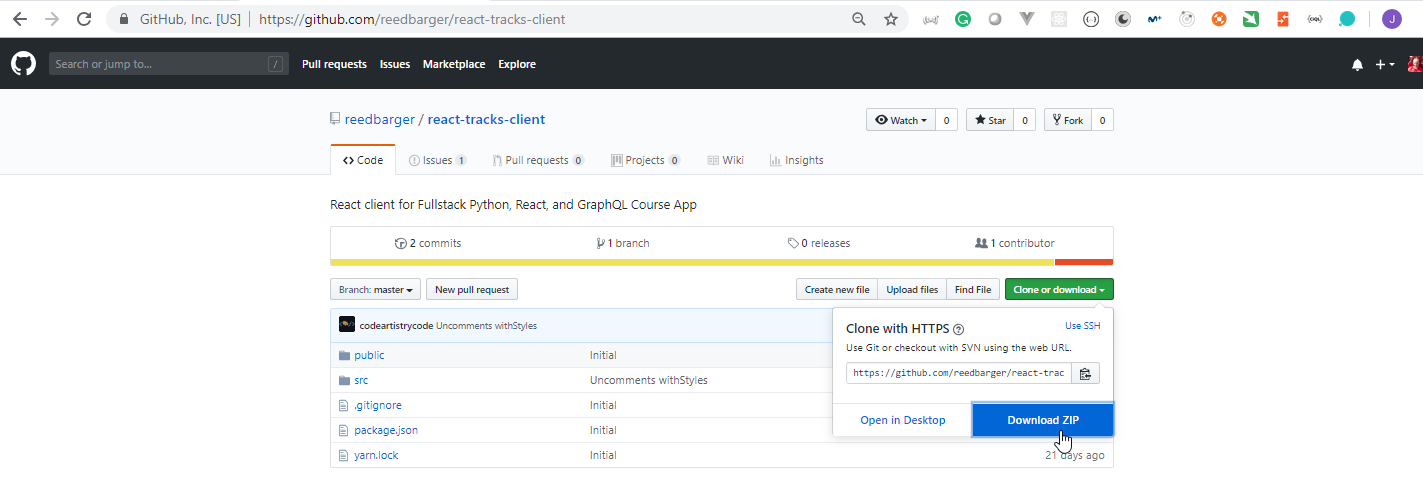
- As we have already created a repository for the full solution we are just going to download the zip file and unzip it on the new
clientfolder.

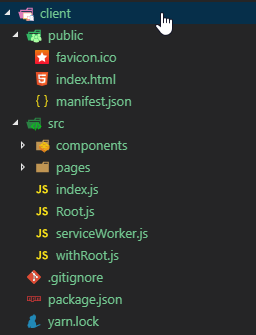
- We need to install the
npm packagesby executingyarn install
client/package.json
{
"name": "client",
"version": "0.1.0",
"private": true,
"dependencies": {
"@material-ui/core": "3.0.1",
"@material-ui/icons": "3.0.1",
"apollo-boost": "^0.1.28",
"axios": "^0.18.0",
"date-fns": "^1.30.1",
"graphql": "^14.1.1",
"react": "^16.8.2",
"react-apollo": "^2.4.1",
"react-dom": "^16.8.2",
"react-player": "^1.9.3",
"react-router-dom": "^4.3.1",
"react-scripts": "2.1.5"
},
"scripts": {
"start": "react-scripts start",
"build": "react-scripts build",
"test": "react-scripts test",
"eject": "react-scripts eject"
},
"eslintConfig": {
"extends": "react-app"
},
"browserslist": [">0.2%", "not dead", "not ie <= 11", "not op_mini all"]
}
Juan.Pablo.Perez@RIMDUB-0232 MINGW64 /c/Work/Training/Pre/GraphQL/full-stack-react-python-and-graphql/react-tracks/client (master)
$ yarn
yarn install v1.15.2
info fsevents@1.2.4: The platform "win32" is incompatible with this module.
info "fsevents@1.2.4" is an optional dependency and failed compatibility check. Excluding it from installation.
[3/4] Linking dependencies...
warning " > react-apollo@2.4.1" has unmet peer dependency "apollo-client@^2.4.12".
warning "react-scripts > pnp-webpack-plugin > ts-pnp@1.0.0" has unmet peer dependency "typescript@*".
[4/4] Building fresh packages...
Done in 182.66s.
- We can run the project by executing
yarn start
Juan.Pablo.Perez@RIMDUB-0232 MINGW64 /c/Work/Training/Pre/GraphQL/full-stack-react-python-and-graphql/react-tracks/client (master)
$ yarn start
yarn run v1.15.2
Starting the development server...
Compiled successfully!
You can now view client in the browser.
Local: http://localhost:3000/
On Your Network: http://10.0.75.1:3000/
Note that the development build is not optimized.
To create a production build, use yarn build.
- It is running on http://localhost:3000/

30. Exploring the React Source Code 6min
- The application has been created by using Create React App

- The entry point of the application is
app/src/index.js
app/src/index.js
import React from "react";
import ReactDOM from "react-dom";
import Root from "./Root";
import * as serviceWorker from "./serviceWorker";
ReactDOM.render(<Root />, document.getElementById("root"));
// If you want your app to work offline and load faster, you can change
// unregister() to register() below. Note this comes with some pitfalls.
// Learn more about service workers: http://bit.ly/CRA-PWA
serviceWorker.unregister();
- This module uses React to render the main component on the
app/src/Root.jsdocument that initially just put Root.
app/src/Root.js
import React from "react";
import withRoot from "./withRoot";
const Root = () => <div>Root</div>;
export default withRoot(Root);
Each user is going to have their own profile page on
/profile/idwhereidis the User Id. We are going to have a login page where the users can authenticate.We have the
pagesfolder where we are going to put our pages. It has initially theApp.jsand theProfile.jsdocuments.
app/src/pages/App.js
import React from "react";
import withStyles from "@material-ui/core/styles/withStyles";
const App = ({ classes }) => {
return <div>App</div>;
};
const styles = theme => ({
container: {
margin: "0 auto",
maxWidth: 960,
padding: theme.spacing.unit * 2
}
});
export default withStyles(styles)(App);
app/src/pages/Profile.js
import React from "react";
import withStyles from "@material-ui/core/styles/withStyles";
// import Card from "@material-ui/core/Card";
// import CardHeader from "@material-ui/core/CardHeader";
// import Avatar from "@material-ui/core/Avatar";
// import Paper from "@material-ui/core/Paper";
// import Typography from "@material-ui/core/Typography";
// import ThumbUpIcon from "@material-ui/icons/ThumbUpTwoTone";
// import AudiotrackIcon from "@material-ui/icons/AudiotrackTwoTone";
// import Divider from "@material-ui/core/Divider";
const Profile = ({ classes }) => {
return <div>Profile</div>;
};
const styles = theme => ({
paper: {
width: "auto",
display: "block",
padding: theme.spacing.unit * 2,
marginLeft: theme.spacing.unit * 3,
marginRight: theme.spacing.unit * 3,
marginTop: theme.spacing.unit * 2,
marginBottom: theme.spacing.unit * 2,
[theme.breakpoints.up("md")]: {
width: 650,
marginLeft: "auto",
marginRight: "auto"
}
},
card: {
display: "flex",
justifyContent: "center"
},
title: {
display: "flex",
alignItems: "center",
marginBottom: theme.spacing.unit * 2
},
audioIcon: {
color: "purple",
fontSize: 30,
marginRight: theme.spacing.unit
},
thumbIcon: {
color: "green",
marginRight: theme.spacing.unit
},
divider: {
marginTop: theme.spacing.unit,
marginBottom: theme.spacing.unit
}
});
export default withStyles(styles)(Profile);
- We have also the
componentsfolder where we are going to put our components. It will have an individual folder for each module.Authwith all the authentication components,Sharedwith all the shared components andTrackwith all the components related to the Tracks.
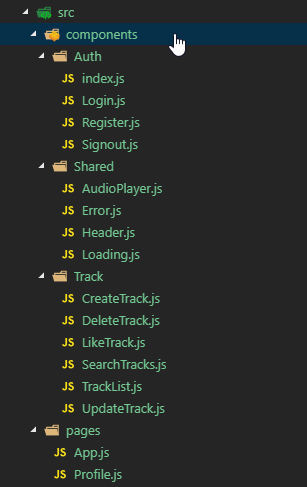
- The application is using the
Material UIlibrary. The set-up of this library is created on theapp/src/withRoot.jsdocument.
app/src/withRoot.js
import React from "react";
import { MuiThemeProvider, createMuiTheme } from "@material-ui/core/styles";
import indigo from "@material-ui/core/colors/indigo";
import orange from "@material-ui/core/colors/orange";
import CssBaseline from "@material-ui/core/CssBaseline";
// A theme with custom primary and secondary color.
// It's optional.
const theme = createMuiTheme({
palette: {
primary: {
light: indigo[500],
main: indigo[700],
dark: indigo[900]
},
secondary: {
light: orange[300],
main: orange[500],
dark: orange[700]
}
},
typography: {
useNextVariants: true
}
});
function withRoot(Component) {
function WithRoot(props) {
// MuiThemeProvider makes the theme available down the React tree
// thanks to React context.
return (
<MuiThemeProvider theme={theme}>
{/* CssBaseline kickstart an elegant, consistent, and simple baseline to build upon. */}
{/* https://material-ui.com/getting-started/usage/#cssbaseline */}
<CssBaseline />
<Component {...props} />
</MuiThemeProvider>
);
}
return WithRoot;
}
export default withRoot;
We can just modify this document if we want to use a different
themeWe can apply individual styles to each
pageorcomponentby defining thestylefunction in each document, as we are doing in theapp/src/components/Auth/Register.jsdocument.
app/src/components/Auth/Register.js
import React from "react";
import withStyles from "@material-ui/core/styles/withStyles";
// import Typography from "@material-ui/core/Typography";
// import Avatar from "@material-ui/core/Avatar";
// import FormControl from "@material-ui/core/FormControl";
// import Paper from "@material-ui/core/Paper";
// import Input from "@material-ui/core/Input";
// import InputLabel from "@material-ui/core/InputLabel";
// import Button from "@material-ui/core/Button";
// import Dialog from "@material-ui/core/Dialog";
// import DialogActions from "@material-ui/core/DialogActions";
// import DialogContent from "@material-ui/core/DialogContent";
// import DialogContentText from "@material-ui/core/DialogContentText";
// import DialogTitle from "@material-ui/core/DialogTitle";
// import Slide from "@material-ui/core/Slide";
// import Gavel from "@material-ui/icons/Gavel";
// import VerifiedUserTwoTone from "@material-ui/icons/VerifiedUserTwoTone";
const Register = ({ classes }) => {
return <div>Register</div>;
};
const styles = theme => ({
root: {
width: "auto",
display: "block",
marginLeft: theme.spacing.unit * 3,
marginRight: theme.spacing.unit * 3,
[theme.breakpoints.up("md")]: {
width: 400,
marginLeft: "auto",
marginRight: "auto"
}
},
paper: {
marginTop: theme.spacing.unit * 8,
display: "flex",
flexDirection: "column",
alignItems: "center",
padding: theme.spacing.unit * 2
},
title: {
marginTop: theme.spacing.unit * 2,
color: theme.palette.openTitle
},
avatar: {
margin: theme.spacing.unit,
backgroundColor: theme.palette.secondary.main
},
form: {
width: "100%",
marginTop: theme.spacing.unit
},
submit: {
marginTop: theme.spacing.unit * 2,
marginBottom: theme.spacing.unit * 2
},
icon: {
padding: "0px 2px 2px 0px",
verticalAlign: "middle",
color: "green"
}
});
export default withStyles(styles)(Register);
31. Setting up Apollo Client / Executing Queries with React Apollo 5min
- We need to modify the
src/index.jsto set up the Apollo Client to be able to run queries.
src/index.js
import React from "react";
import ReactDOM from "react-dom";
import Root from "./Root";
import * as serviceWorker from "./serviceWorker";
import { ApolloProvider } from "react-apollo";
import ApolloClient from "apollo-boost";
const client = new ApolloClient({
uri: "http://localhost:9000/graphql/"
});
ReactDOM.render(
<ApolloProvider client={client}>
<Root />
</ApolloProvider>,
document.getElementById("root")
);
// If you want your app to work offline and load faster, you can change
// unregister() to register() below. Note this comes with some pitfalls.
// Learn more about service workers: http://bit.ly/CRA-PWA
serviceWorker.unregister();
- We also need to modify the
src/Root.jsto set up the Apollo Client.
src/Root.js
import React from "react";
import withRoot from "./withRoot";
import { Query } from "react-apollo";
import { gql } from "apollo-boost";
const Root = () => (
<Query query={GET_TRACKS_QUERY}>
{({ data, loading, error }) => {
if (loading) return <div>Loading</div>;
if (error) return <div>Error</div>;
return <div>{JSON.stringify(data)}</div>;
}}
</Query>
);
const GET_TRACKS_QUERY = gql`
{
tracks {
id
title
description
url
}
}
`;
export default withRoot(Root);
SettingUpApolloClientExecutingQueriesWithReactApollo SettingUpApolloClientExecutingQueriesWithReactApollo2 SettingUpApolloClientExecutingQueriesWithReactApollo3 SettingUpApolloClientExecutingQueriesWithReactApollo4 SettingUpApolloClientExecutingQueriesWithReactApollo5
32. Enabling django-cors-headers for Connecting to our Backend 4min
- We need to run the
djangoapp in one terminal
Juan.Pablo.Perez@RIMDUB-0232 MINGW64 /c/Work/Training/Pre/GraphQL/full-stack-react-python-and-graphql/react-tracks (master)
$ pipenv shell
Launching subshell in virtual environment…
Juan.Pablo.Perez@RIMDUB-0232 MINGW64 /c/Work/Training/Pre/GraphQL/full-stack-react-python-and-graphql/react-tracks (master)
$ cd app
Juan.Pablo.Perez@RIMDUB-0232 MINGW64 /c/Work/Training/Pre/GraphQL/full-stack-react-python-and-graphql/react-tracks/app (master)
$ python manage.py runserver 9000
Performing system checks...
System check identified no issues (0 silenced).
April 04, 2019 - 19:00:09
Django version 2.1.7, using settings 'app.settings'
Starting development server at http://127.0.0.1:9000/
Quit the server with CTRL-BREAK.
- We need to start the
reactapp in another terminal
Juan.Pablo.Perez@RIMDUB-0232 MINGW64 /c/Work/Training/Pre/GraphQL/full-stack-react-python-and-graphql/react-tracks (master)$ cd client
Juan.Pablo.Perez@RIMDUB-0232 MINGW64 /c/Work/Training/Pre/GraphQL/full-stack-react-python-and-graphql/react-tracks/client (master)
$ yarn start
yarn run v1.15.2
Starting the development server...
Compiled successfully!
You can now view client in the browser.
Local: http://localhost:3000/
On Your Network: http://10.0.75.1:3000/
Note that the development build is not optimized.
To create a production build, use yarn build.
- But we can notice there are errors when browsing.

- We have to tell
djangothat we can receive request from a differentendpoint. We have already a special package installed to manage thatdjango-cors-headers
Pipfile
[[source]]
name = "pypi"
url = "https://pypi.org/simple"
verify_ssl = true
[dev-packages]
autopep8 = "*"
pylint = "*"
[packages]
django = "*"
graphene-django = "*"
django-graphql-jwt = "*"
django-cors-headers = "*"
[requires]
python_version = "3.7"
- We can check the
djangodocumentation to see how to manage headers on django-cors-headers

- We need to modify the
app/app/settings.pydocument to tellDjangowe want to use thecorsheadersApp. - We need to add the
corsheadersname to theINSTALLED_APPSarray andcorsheaders.middleware.CorsMiddlewareanddjango.middleware.common.CommonMiddlewareto theMIDDLEWAREobject. - We finnaly have to add another
CORS_ORIGIN_WHITELISTwith the list of endpoints that are going to have access to the API.
app/app/settings.py
"""
Django settings for app project.
Generated by 'django-admin startproject' using Django 2.1.7.
For more information on this file, see
https://docs.djangoproject.com/en/2.1/topics/settings/
For the full list of settings and their values, see
https://docs.djangoproject.com/en/2.1/ref/settings/
"""
import os
# Build paths inside the project like this: os.path.join(BASE_DIR, ...)
BASE_DIR = os.path.dirname(os.path.dirname(os.path.abspath(__file__)))
# Quick-start development settings - unsuitable for production
# See https://docs.djangoproject.com/en/2.1/howto/deployment/checklist/
# SECURITY WARNING: keep the secret key used in production secret!
SECRET_KEY = 'kpwro5ldvma_r_nlb&_cjtwm0emgpr@#x1-vlm3lb84f!7!-m0'
# SECURITY WARNING: don't run with debug turned on in production!
DEBUG = True
ALLOWED_HOSTS = []
# Application definition
INSTALLED_APPS = [
'corsheaders',
'django.contrib.admin',
'django.contrib.auth',
'django.contrib.contenttypes',
'django.contrib.sessions',
'django.contrib.messages',
'django.contrib.staticfiles',
'graphene_django',
'tracks'
]
GRAPHENE = {
'SCHEMA': 'app.schema.schema',
'MIDDLEWARE': [
'graphql_jwt.middleware.JSONWebTokenMiddleware',
],
}
MIDDLEWARE = [
'corsheaders.middleware.CorsMiddleware',
'django.middleware.common.CommonMiddleware',
'django.middleware.security.SecurityMiddleware',
'django.contrib.sessions.middleware.SessionMiddleware',
'django.middleware.common.CommonMiddleware',
'django.middleware.csrf.CsrfViewMiddleware',
'django.contrib.auth.middleware.AuthenticationMiddleware',
'django.contrib.messages.middleware.MessageMiddleware',
'django.middleware.clickjacking.XFrameOptionsMiddleware',
'django.contrib.auth.middleware.AuthenticationMiddleware',
]
CORS_ORIGIN_WHITELIST = (
'localhost:3000'
)
AUTHENTICATION_BACKENDS = [
'graphql_jwt.backends.JSONWebTokenBackend',
'django.contrib.auth.backends.ModelBackend',
]
ROOT_URLCONF = 'app.urls'
TEMPLATES = [
{
'BACKEND': 'django.template.backends.django.DjangoTemplates',
'DIRS': [],
'APP_DIRS': True,
'OPTIONS': {
'context_processors': [
'django.template.context_processors.debug',
'django.template.context_processors.request',
'django.contrib.auth.context_processors.auth',
'django.contrib.messages.context_processors.messages',
],
},
},
]
WSGI_APPLICATION = 'app.wsgi.application'
# Database
# https://docs.djangoproject.com/en/2.1/ref/settings/#databases
DATABASES = {
'default': {
'ENGINE': 'django.db.backends.sqlite3',
'NAME': os.path.join(BASE_DIR, 'db.sqlite3'),
}
}
# Password validation
# https://docs.djangoproject.com/en/2.1/ref/settings/#auth-password-validators
AUTH_PASSWORD_VALIDATORS = [
{
'NAME': 'django.contrib.auth.password_validation.UserAttributeSimilarityValidator',
},
{
'NAME': 'django.contrib.auth.password_validation.MinimumLengthValidator',
},
{
'NAME': 'django.contrib.auth.password_validation.CommonPasswordValidator',
},
{
'NAME': 'django.contrib.auth.password_validation.NumericPasswordValidator',
},
]
# Internationalization
# https://docs.djangoproject.com/en/2.1/topics/i18n/
LANGUAGE_CODE = 'en-us'
TIME_ZONE = 'UTC'
USE_I18N = True
USE_L10N = True
USE_TZ = True
# Static files (CSS, JavaScript, Images)
# https://docs.djangoproject.com/en/2.1/howto/static-files/
STATIC_URL = '/static/'
- We can refresh the browser and see that we are now receiving the list of
Tracks.

33. Creating our Register Form 8min
- We are going to modify the
client/src/index.jsto show theRootor theAuthcomponents depending on if the user is authenticated or not.
client/src/index.js
import React from "react";
import ReactDOM from "react-dom";
import * as serviceWorker from "./serviceWorker";
import { ApolloProvider } from "react-apollo";
import ApolloClient from "apollo-boost";
import Root from "./Root";
import Auth from "./components/Auth";
const client = new ApolloClient({
uri: "http://localhost:9000/graphql/"
});
ReactDOM.render(
<ApolloProvider client={client}>
<Auth />
</ApolloProvider>,
document.getElementById("root")
);
// If you want your app to work offline and load faster, you can change
// unregister() to register() below. Note this comes with some pitfalls.
// Learn more about service workers: http://bit.ly/CRA-PWA
serviceWorker.unregister();
src/Auth/index.js
import React from "react";
import withRoot from "../../withRoot";
export default withRoot(() => {
return <div>Auth</div>;
});

- The
src/Auth/index.jsis going to show either theLogincomponent or theRegistercomponent.
src/Auth/index.js
import React from "react";
import withRoot from "../../withRoot";
import Login from "./Login";
import Register from "./Register";
export default withRoot(() => {
return <Register />;
});
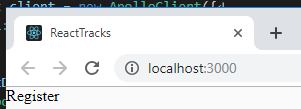
- We are going to complete the
Registercomponent.
src/Auth/Register.js
import React from "react";
import { Mutation } from "react-apollo";
import { gql } from "apollo-boost";
import withStyles from "@material-ui/core/styles/withStyles";
import Typography from "@material-ui/core/Typography";
import Avatar from "@material-ui/core/Avatar";
import FormControl from "@material-ui/core/FormControl";
import Paper from "@material-ui/core/Paper";
import Input from "@material-ui/core/Input";
import InputLabel from "@material-ui/core/InputLabel";
import Button from "@material-ui/core/Button";
import Dialog from "@material-ui/core/Dialog";
import DialogActions from "@material-ui/core/DialogActions";
import DialogContent from "@material-ui/core/DialogContent";
import DialogContentText from "@material-ui/core/DialogContentText";
import DialogTitle from "@material-ui/core/DialogTitle";
import Slide from "@material-ui/core/Slide";
import Gavel from "@material-ui/icons/Gavel";
import VerifiedUserTwoTone from "@material-ui/icons/VerifiedUserTwoTone";
const Register = ({ classes }) => {
return (
<div className={classes.root}>
<Paper className={classes.paper}>
<Avatar className={classes.avatar}>
<Gavel />
</Avatar>
</Paper>
<Typography variant="headline">Register</Typography>
{/* <Mutation>
{() => {
return ( */}
<form className={classes.form}>
<FormControl margin="normal" required fullWidth>
<InputLabel htmlFor="username">Username</InputLabel>
<Input id="username" />
</FormControl>
<FormControl margin="normal" required fullWidth>
<InputLabel htmlFor="email">Email</InputLabel>
<Input id="email" type="email" />
</FormControl>
<FormControl margin="normal" required fullWidth>
<InputLabel htmlFor="password">Password</InputLabel>
<Input id="password" type="password" />
</FormControl>
<Button
type="submit"
fullWidth
variant="contained"
color="secondary"
className={classes.submit}
>
Register
</Button>
<Button color="primary" variant="outlined" fullWidth>
Previous user? Log in here
</Button>
</form>
{/* );
}}
</Mutation> */}
</div>
);
};
const styles = theme => ({
root: {
width: "auto",
display: "block",
marginLeft: theme.spacing.unit * 3,
marginRight: theme.spacing.unit * 3,
[theme.breakpoints.up("md")]: {
width: 400,
marginLeft: "auto",
marginRight: "auto"
}
},
paper: {
marginTop: theme.spacing.unit * 8,
display: "flex",
flexDirection: "column",
alignItems: "center",
padding: theme.spacing.unit * 2
},
title: {
marginTop: theme.spacing.unit * 2,
color: theme.palette.openTitle
},
avatar: {
margin: theme.spacing.unit,
backgroundColor: theme.palette.secondary.main
},
form: {
width: "100%",
marginTop: theme.spacing.unit
},
submit: {
marginTop: theme.spacing.unit * 2,
marginBottom: theme.spacing.unit * 2
},
icon: {
padding: "0px 2px 2px 0px",
verticalAlign: "middle",
color: "green"
}
});
export default withStyles(styles)(Register);
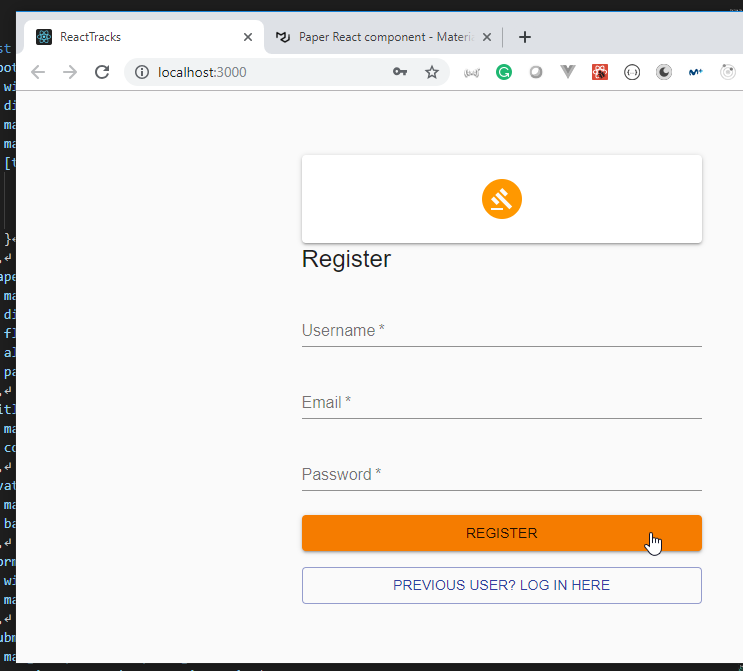
34. Executing GraphQL Operations Client-Side with Apollo Dev Tools 4min
- We can install Apollo Client Devtools to have access to the Apollo Client from the
Chrome Development tools
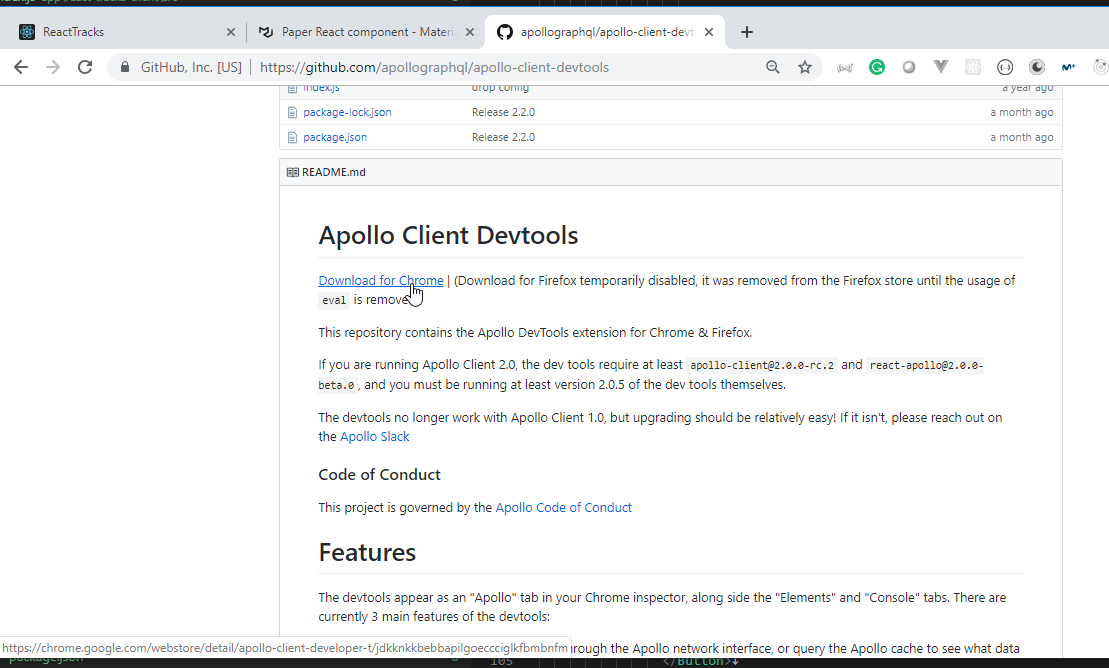

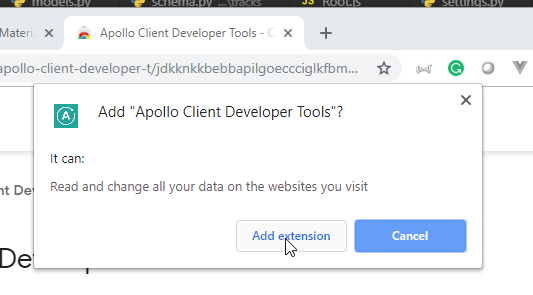

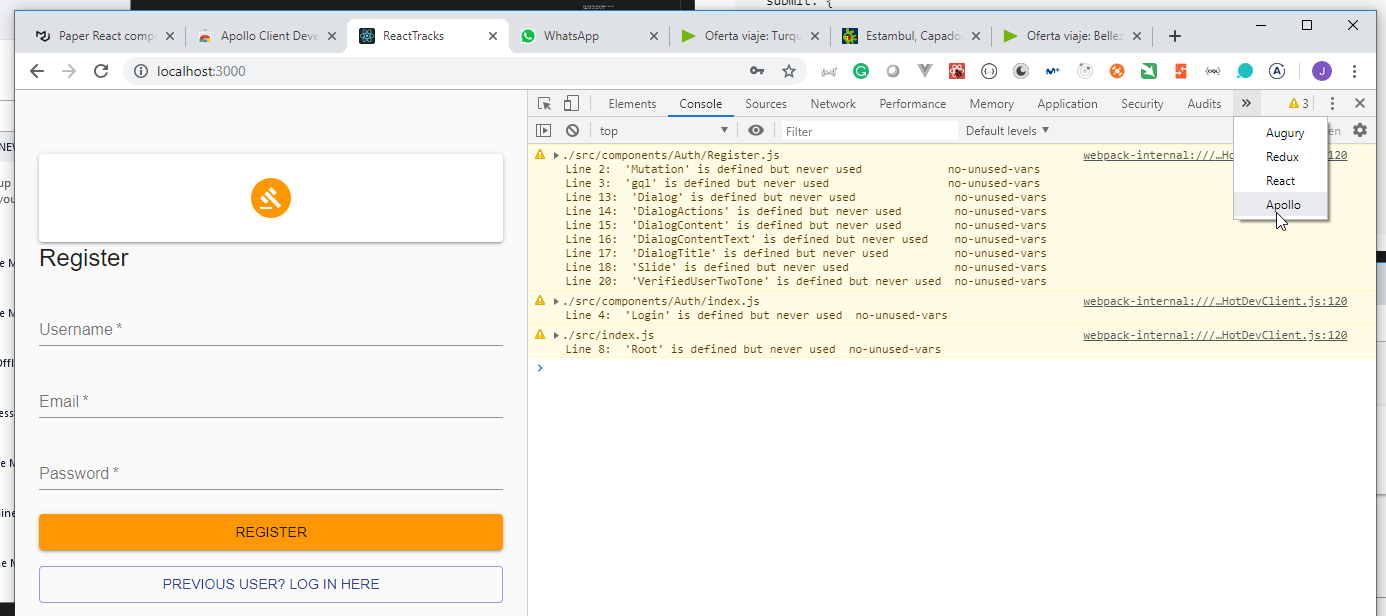



35. Storing Form State with useState 5min
Once we've ensured the mutation is valid we can copy it and paste in the
Registercomponent.We are also going to use
useStatefrom React to manage the state in the form.
src/Auth/Register.js
import React, { useState } from "react";
import { Mutation } from "react-apollo";
import { gql } from "apollo-boost";
import withStyles from "@material-ui/core/styles/withStyles";
import Typography from "@material-ui/core/Typography";
import Avatar from "@material-ui/core/Avatar";
import FormControl from "@material-ui/core/FormControl";
import Paper from "@material-ui/core/Paper";
import Input from "@material-ui/core/Input";
import InputLabel from "@material-ui/core/InputLabel";
import Button from "@material-ui/core/Button";
import Dialog from "@material-ui/core/Dialog";
import DialogActions from "@material-ui/core/DialogActions";
import DialogContent from "@material-ui/core/DialogContent";
import DialogContentText from "@material-ui/core/DialogContentText";
import DialogTitle from "@material-ui/core/DialogTitle";
import Slide from "@material-ui/core/Slide";
import Gavel from "@material-ui/icons/Gavel";
import VerifiedUserTwoTone from "@material-ui/icons/VerifiedUserTwoTone";
const Register = ({ classes }) => {
// First value is the name of the variable for the state
// Second value is the name of the function that we are going to use to change the value
const [username, setUsername] = useState("");
const [email, setEmail] = useState("");
const [password, setPassword] = useState("");
return (
<div className={classes.root}>
<Paper className={classes.paper}>
<Avatar className={classes.avatar}>
<Gavel />
</Avatar>
</Paper>
<Typography variant="headline">Register</Typography>
<Mutation mutation={REGISTER_MUTATION}>
{() => {
return (
<form className={classes.form}>
<FormControl margin="normal" required fullWidth>
<InputLabel htmlFor="username">Username</InputLabel>
<Input
id="username"
onChange={event => setUsername(event.target.value)}
/>
</FormControl>
<FormControl margin="normal" required fullWidth>
<InputLabel htmlFor="email">Email</InputLabel>
<Input
id="email"
type="email"
onChange={event => setEmail(event.target.value)}
/>
</FormControl>
<FormControl margin="normal" required fullWidth>
<InputLabel htmlFor="password">Password</InputLabel>
<Input
id="password"
type="password"
onChange={event => setPassword(event.target.value)}
/>
</FormControl>
<Button
type="submit"
fullWidth
variant="contained"
color="secondary"
className={classes.submit}
>
Register
</Button>
<Button color="primary" variant="outlined" fullWidth>
Previous user? Log in here
</Button>
</form>
);
}}
</Mutation>
</div>
);
};
const REGISTER_MUTATION = gql`
mutation($username: String!, $email: String!, $password: String!) {
createUser(username: $username, email: $email, password: $password) {
user {
username
email
}
}
}
`;
const styles = theme => ({
root: {
width: "auto",
display: "block",
marginLeft: theme.spacing.unit * 3,
marginRight: theme.spacing.unit * 3,
[theme.breakpoints.up("md")]: {
width: 400,
marginLeft: "auto",
marginRight: "auto"
}
},
paper: {
marginTop: theme.spacing.unit * 8,
display: "flex",
flexDirection: "column",
alignItems: "center",
padding: theme.spacing.unit * 2
},
title: {
marginTop: theme.spacing.unit * 2,
color: theme.palette.openTitle
},
avatar: {
margin: theme.spacing.unit,
backgroundColor: theme.palette.secondary.main
},
form: {
width: "100%",
marginTop: theme.spacing.unit
},
submit: {
marginTop: theme.spacing.unit * 2,
marginBottom: theme.spacing.unit * 2
},
icon: {
padding: "0px 2px 2px 0px",
verticalAlign: "middle",
color: "green"
}
});
export default withStyles(styles)(Register);
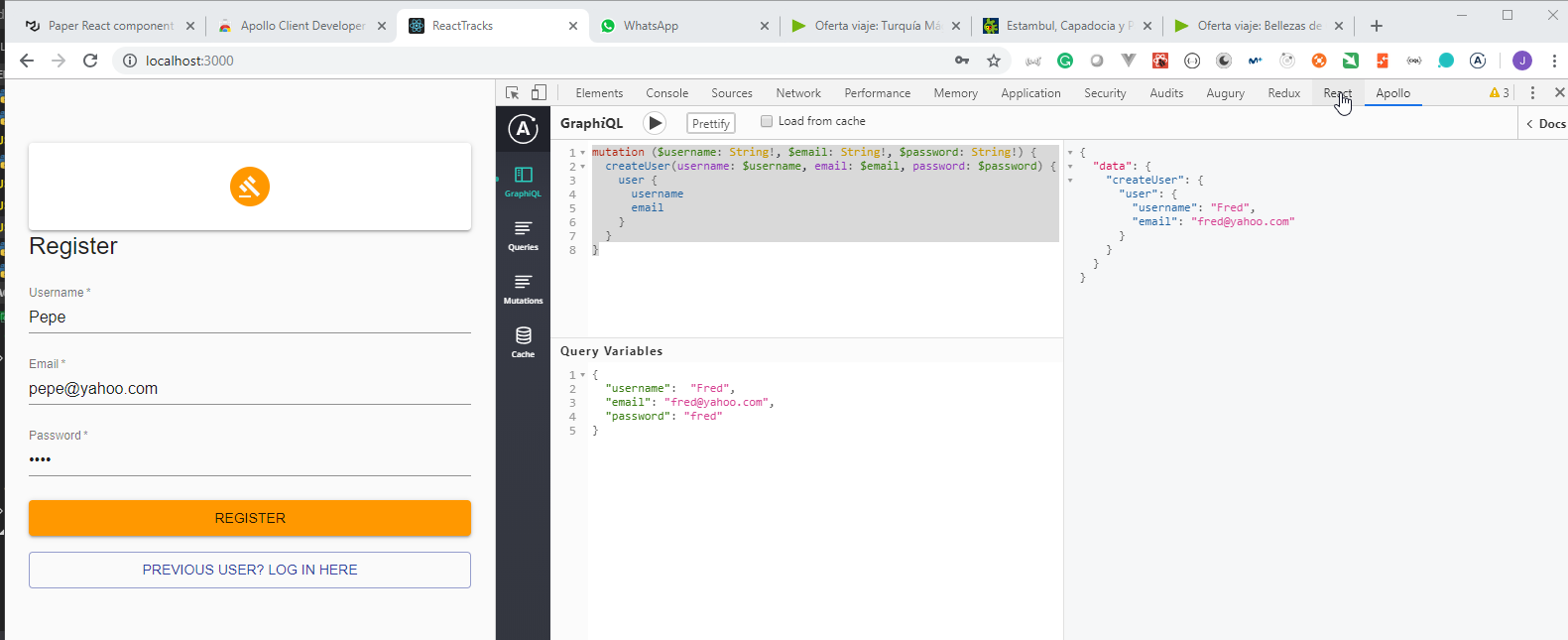

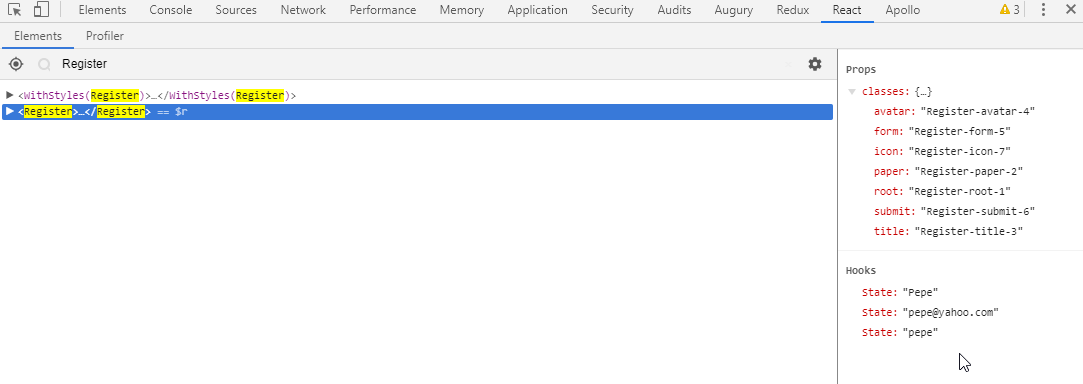
36. Executing Mutations with Mutation Component / Register User Mutation 6min
- We are going to modify the
Registercomponent to get access to thecreateUsermutation.
src/Auth/Register.js
import React, { useState } from "react";
import { Mutation } from "react-apollo";
import { gql } from "apollo-boost";
import withStyles from "@material-ui/core/styles/withStyles";
import Typography from "@material-ui/core/Typography";
import Avatar from "@material-ui/core/Avatar";
import FormControl from "@material-ui/core/FormControl";
import Paper from "@material-ui/core/Paper";
import Input from "@material-ui/core/Input";
import InputLabel from "@material-ui/core/InputLabel";
import Button from "@material-ui/core/Button";
import Dialog from "@material-ui/core/Dialog";
import DialogActions from "@material-ui/core/DialogActions";
import DialogContent from "@material-ui/core/DialogContent";
import DialogContentText from "@material-ui/core/DialogContentText";
import DialogTitle from "@material-ui/core/DialogTitle";
import Slide from "@material-ui/core/Slide";
import Gavel from "@material-ui/icons/Gavel";
import VerifiedUserTwoTone from "@material-ui/icons/VerifiedUserTwoTone";
const Register = ({ classes }) => {
// First value is the name of the variable for the state
// Second value is the name of the function that we are going to use to change the value
const [username, setUsername] = useState("");
const [email, setEmail] = useState("");
const [password, setPassword] = useState("");
const handleSubmit = async (event, createUser) => {
event.preventDefault();
const res = await createUser();
console.log({ res });
};
return (
<div className={classes.root}>
<Paper className={classes.paper}>
<Avatar className={classes.avatar}>
<Gavel />
</Avatar>
</Paper>
<Typography variant="headline">Register</Typography>
<Mutation
mutation={REGISTER_MUTATION}
variables={{ username, email, password }}
>
{(createUser, { loading, error }) => {
return (
<form
onSubmit={event => handleSubmit(event, createUser)}
className={classes.form}
>
<FormControl margin="normal" required fullWidth>
<InputLabel htmlFor="username">Username</InputLabel>
<Input
id="username"
onChange={event => setUsername(event.target.value)}
/>
</FormControl>
<FormControl margin="normal" required fullWidth>
<InputLabel htmlFor="email">Email</InputLabel>
<Input
id="email"
type="email"
onChange={event => setEmail(event.target.value)}
/>
</FormControl>
<FormControl margin="normal" required fullWidth>
<InputLabel htmlFor="password">Password</InputLabel>
<Input
id="password"
type="password"
onChange={event => setPassword(event.target.value)}
/>
</FormControl>
<Button
type="submit"
fullWidth
variant="contained"
color="secondary"
className={classes.submit}
>
Register
</Button>
<Button color="primary" variant="outlined" fullWidth>
Previous user? Log in here
</Button>
</form>
);
}}
</Mutation>
</div>
);
};
const REGISTER_MUTATION = gql`
mutation($username: String!, $email: String!, $password: String!) {
createUser(username: $username, email: $email, password: $password) {
user {
username
email
}
}
}
`;
const styles = theme => ({
root: {
width: "auto",
display: "block",
marginLeft: theme.spacing.unit * 3,
marginRight: theme.spacing.unit * 3,
[theme.breakpoints.up("md")]: {
width: 400,
marginLeft: "auto",
marginRight: "auto"
}
},
paper: {
marginTop: theme.spacing.unit * 8,
display: "flex",
flexDirection: "column",
alignItems: "center",
padding: theme.spacing.unit * 2
},
title: {
marginTop: theme.spacing.unit * 2,
color: theme.palette.openTitle
},
avatar: {
margin: theme.spacing.unit,
backgroundColor: theme.palette.secondary.main
},
form: {
width: "100%",
marginTop: theme.spacing.unit
},
submit: {
marginTop: theme.spacing.unit * 2,
marginBottom: theme.spacing.unit * 2
},
icon: {
padding: "0px 2px 2px 0px",
verticalAlign: "middle",
color: "green"
}
});
export default withStyles(styles)(Register);
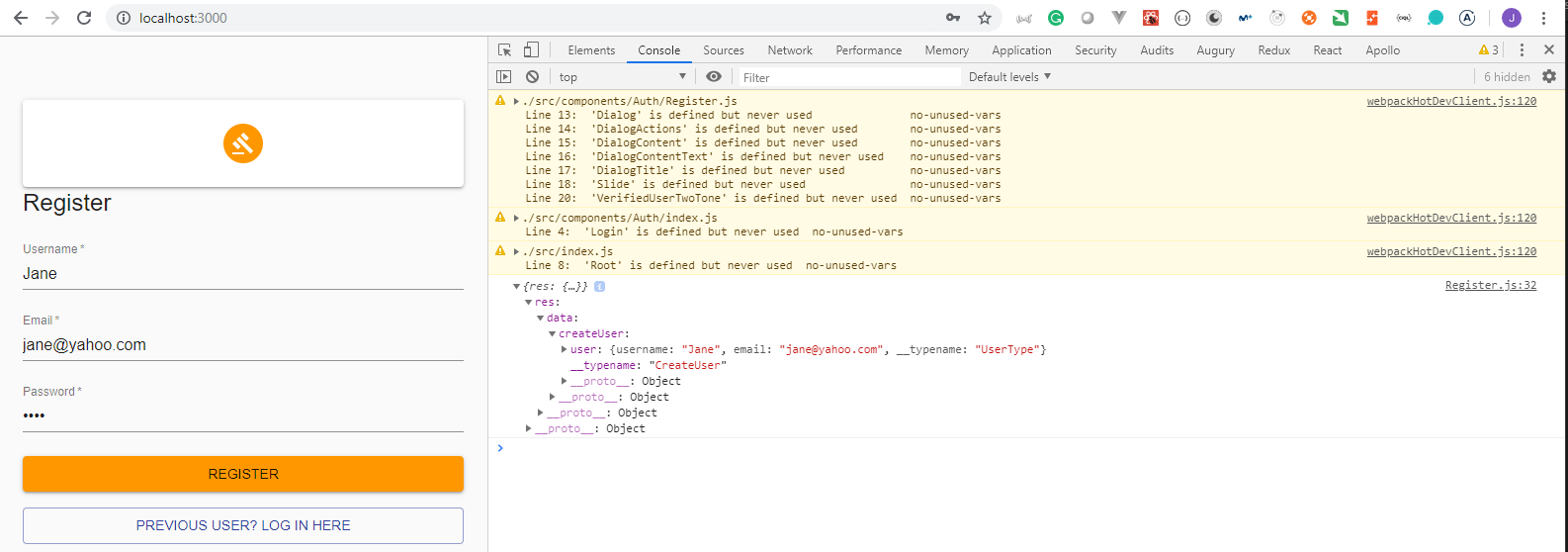
37. Finishing Register (Success Dialog, Toggling Auth Components, Transitions) 13min
We are going to modify the
Registercomponent to display a modal form telling the user the login was succesfull and also the user needs to log in.In order to get the information about the user when is logged in in the
Registercomponent we need to modify thesrc/Auth/index.jsdocument
src/Auth/index.js
import React, { useState } from "react";
import withRoot from "../../withRoot";
import Login from "./Login";
import Register from "./Register";
export default withRoot(() => {
const [newUser, setNewUser] = useState(true);
return newUser ? <Register setNewUser={setNewUser} /> : <Login />;
});
src/Auth/Register.js
import React, { useState } from "react";
import { Mutation } from "react-apollo";
import { gql } from "apollo-boost";
import withStyles from "@material-ui/core/styles/withStyles";
import Typography from "@material-ui/core/Typography";
import Avatar from "@material-ui/core/Avatar";
import FormControl from "@material-ui/core/FormControl";
import Paper from "@material-ui/core/Paper";
import Input from "@material-ui/core/Input";
import InputLabel from "@material-ui/core/InputLabel";
import Button from "@material-ui/core/Button";
import Dialog from "@material-ui/core/Dialog";
import DialogActions from "@material-ui/core/DialogActions";
import DialogContent from "@material-ui/core/DialogContent";
import DialogContentText from "@material-ui/core/DialogContentText";
import DialogTitle from "@material-ui/core/DialogTitle";
import Slide from "@material-ui/core/Slide";
import Gavel from "@material-ui/icons/Gavel";
import VerifiedUserTwoTone from "@material-ui/icons/VerifiedUserTwoTone";
function Transition(props) {
return <Slide direction="up" {...props} />;
}
const Register = ({ classes, setNewUser }) => {
// First value is the name of the variable for the state
// Second value is the name of the function that we are going to use to change the value
const [username, setUsername] = useState("");
const [email, setEmail] = useState("");
const [password, setPassword] = useState("");
const [open, setOpen] = useState(false);
const handleSubmit = (event, createUser) => {
event.preventDefault();
createUser();
};
return (
<div className={classes.root}>
<Paper className={classes.paper}>
<Avatar className={classes.avatar}>
<Gavel />
</Avatar>
<Typography variant="headline">Register</Typography>
<Mutation
mutation={REGISTER_MUTATION}
variables={{ username, email, password }}
onCompleted={data => {
console.log({ data });
setOpen(true);
}}
>
{(createUser, { loading, error }) => {
return (
<form
onSubmit={event => handleSubmit(event, createUser)}
className={classes.form}
>
<FormControl margin="normal" required fullWidth>
<InputLabel htmlFor="username">Username</InputLabel>
<Input
id="username"
onChange={event => setUsername(event.target.value)}
/>
</FormControl>
<FormControl margin="normal" required fullWidth>
<InputLabel htmlFor="email">Email</InputLabel>
<Input
id="email"
type="email"
onChange={event => setEmail(event.target.value)}
/>
</FormControl>
<FormControl margin="normal" required fullWidth>
<InputLabel htmlFor="password">Password</InputLabel>
<Input
id="password"
type="password"
onChange={event => setPassword(event.target.value)}
/>
</FormControl>
<Button
type="submit"
fullWidth
variant="contained"
color="secondary"
disabled={
loading ||
!username.trim() ||
!email.trim() ||
!password.trim()
}
className={classes.submit}
>
{loading ? "Registering..." : "Register"}
</Button>
<Button
onClick={() => setNewUser(false)}
color="primary"
variant="outlined"
fullWidth
>
Previous user? Log in here
</Button>
{/* Error Handling */}
{error && <div>>{error}</div>}
</form>
);
}}
</Mutation>
</Paper>
{/* Success Dialog */}
<Dialog
open={open}
disableBackdropClick={true}
TransitionComponent={Transition}
>
<DialogTitle>
<VerifiedUserTwoTone className={classes.icon} />
New Account
</DialogTitle>
<DialogContent>
<DialogContentText>User successfully created!</DialogContentText>
</DialogContent>
<DialogActions>
<Button
color="primary"
variant="contained"
onClick={() => setNewUser(false)}
>
Login
</Button>
</DialogActions>
</Dialog>
</div>
);
};
const REGISTER_MUTATION = gql`
mutation($username: String!, $email: String!, $password: String!) {
createUser(username: $username, email: $email, password: $password) {
user {
username
email
}
}
}
`;
const styles = theme => ({
root: {
width: "auto",
display: "block",
marginLeft: theme.spacing.unit * 3,
marginRight: theme.spacing.unit * 3,
[theme.breakpoints.up("md")]: {
width: 400,
marginLeft: "auto",
marginRight: "auto"
}
},
paper: {
marginTop: theme.spacing.unit * 8,
display: "flex",
flexDirection: "column",
alignItems: "center",
padding: theme.spacing.unit * 2
},
title: {
marginTop: theme.spacing.unit * 2,
color: theme.palette.openTitle
},
avatar: {
margin: theme.spacing.unit,
backgroundColor: theme.palette.secondary.main
},
form: {
width: "100%",
marginTop: theme.spacing.unit
},
submit: {
marginTop: theme.spacing.unit * 2,
marginBottom: theme.spacing.unit * 2
},
icon: {
padding: "0px 2px 2px 0px",
verticalAlign: "middle",
color: "green"
}
});
export default withStyles(styles)(Register);
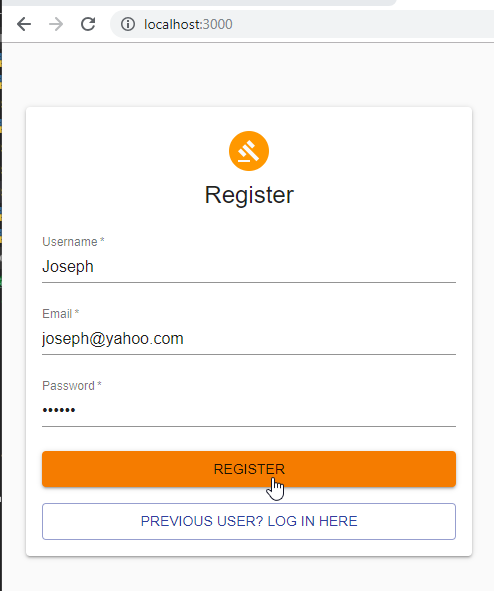

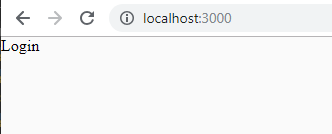
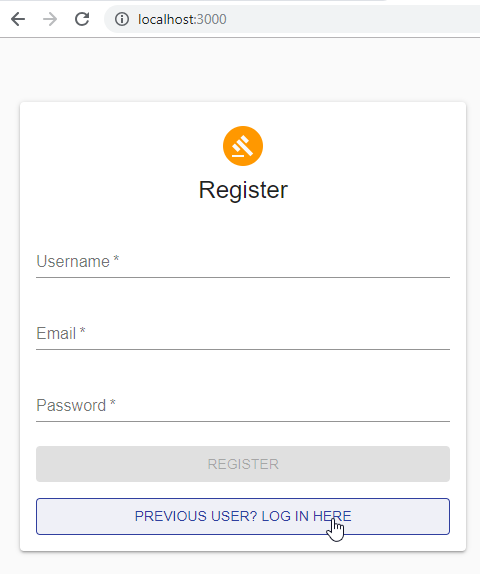
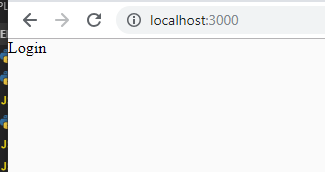
38. Custom Error Component / Improved Error Handling 6min
- We are going to modify the
Auth/Registerand theShared/Errorcomponents to improve the error handling.
src/Shared/Error.js
import React, { useState } from "react";
import withStyles from "@material-ui/core/styles/withStyles";
import Button from "@material-ui/core/Button";
import Snackbar from "@material-ui/core/Snackbar";
const Error = ({ classes, error }) => {
const [open, setOpen] = useState(true);
return (
<Snackbar
open={open}
className={classes.snackbar}
message={error.message}
action={
<Button onClick={() => setOpen(false)} color="secondary" size="small">
Close
</Button>
}
/>
);
};
const styles = theme => ({
snackbar: {
margin: theme.spacing.unit
}
});
export default withStyles(styles)(Error);
src/Auth/Register.js
import React, { useState } from "react";
import { Mutation } from "react-apollo";
import { gql } from "apollo-boost";
import withStyles from "@material-ui/core/styles/withStyles";
import Typography from "@material-ui/core/Typography";
import Avatar from "@material-ui/core/Avatar";
import FormControl from "@material-ui/core/FormControl";
import Paper from "@material-ui/core/Paper";
import Input from "@material-ui/core/Input";
import InputLabel from "@material-ui/core/InputLabel";
import Button from "@material-ui/core/Button";
import Dialog from "@material-ui/core/Dialog";
import DialogActions from "@material-ui/core/DialogActions";
import DialogContent from "@material-ui/core/DialogContent";
import DialogContentText from "@material-ui/core/DialogContentText";
import DialogTitle from "@material-ui/core/DialogTitle";
import Slide from "@material-ui/core/Slide";
import Gavel from "@material-ui/icons/Gavel";
import VerifiedUserTwoTone from "@material-ui/icons/VerifiedUserTwoTone";
import Error from "../Shared/Error";
function Transition(props) {
return <Slide direction="up" {...props} />;
}
const Register = ({ classes, setNewUser }) => {
// First value is the name of the variable for the state
// Second value is the name of the function that we are going to use to change the value
const [username, setUsername] = useState("");
const [email, setEmail] = useState("");
const [password, setPassword] = useState("");
const [open, setOpen] = useState(false);
const handleSubmit = (event, createUser) => {
event.preventDefault();
createUser();
};
return (
<div className={classes.root}>
<Paper className={classes.paper}>
<Avatar className={classes.avatar}>
<Gavel />
</Avatar>
<Typography variant="headline">Register</Typography>
<Mutation
mutation={REGISTER_MUTATION}
variables={{ username, email, password }}
onCompleted={data => {
console.log({ data });
setOpen(true);
}}
>
{(createUser, { loading, error }) => {
return (
<form
onSubmit={event => handleSubmit(event, createUser)}
className={classes.form}
>
<FormControl margin="normal" required fullWidth>
<InputLabel htmlFor="username">Username</InputLabel>
<Input
id="username"
onChange={event => setUsername(event.target.value)}
/>
</FormControl>
<FormControl margin="normal" required fullWidth>
<InputLabel htmlFor="email">Email</InputLabel>
<Input
id="email"
type="email"
onChange={event => setEmail(event.target.value)}
/>
</FormControl>
<FormControl margin="normal" required fullWidth>
<InputLabel htmlFor="password">Password</InputLabel>
<Input
id="password"
type="password"
onChange={event => setPassword(event.target.value)}
/>
</FormControl>
<Button
type="submit"
fullWidth
variant="contained"
color="secondary"
disabled={
loading ||
!username.trim() ||
!email.trim() ||
!password.trim()
}
className={classes.submit}
>
{loading ? "Registering..." : "Register"}
</Button>
<Button
onClick={() => setNewUser(false)}
color="primary"
variant="outlined"
fullWidth
>
Previous user? Log in here
</Button>
{/* Error Handling */}
{error && <Error error={error} />}
</form>
);
}}
</Mutation>
</Paper>
{/* Success Dialog */}
<Dialog
open={open}
disableBackdropClick={true}
TransitionComponent={Transition}
>
<DialogTitle>
<VerifiedUserTwoTone className={classes.icon} />
New Account
</DialogTitle>
<DialogContent>
<DialogContentText>User successfully created!</DialogContentText>
</DialogContent>
<DialogActions>
<Button
color="primary"
variant="contained"
onClick={() => setNewUser(false)}
>
Login
</Button>
</DialogActions>
</Dialog>
</div>
);
};
const REGISTER_MUTATION = gql`
mutation($username: String!, $email: String!, $password: String!) {
createUser(username: $username, email: $email, password: $password) {
user {
username
email
}
}
}
`;
const styles = theme => ({
root: {
width: "auto",
display: "block",
marginLeft: theme.spacing.unit * 3,
marginRight: theme.spacing.unit * 3,
[theme.breakpoints.up("md")]: {
width: 400,
marginLeft: "auto",
marginRight: "auto"
}
},
paper: {
marginTop: theme.spacing.unit * 8,
display: "flex",
flexDirection: "column",
alignItems: "center",
padding: theme.spacing.unit * 2
},
title: {
marginTop: theme.spacing.unit * 2,
color: theme.palette.openTitle
},
avatar: {
margin: theme.spacing.unit,
backgroundColor: theme.palette.secondary.main
},
form: {
width: "100%",
marginTop: theme.spacing.unit
},
submit: {
marginTop: theme.spacing.unit * 2,
marginBottom: theme.spacing.unit * 2
},
icon: {
padding: "0px 2px 2px 0px",
verticalAlign: "middle",
color: "green"
}
});
export default withStyles(styles)(Register);
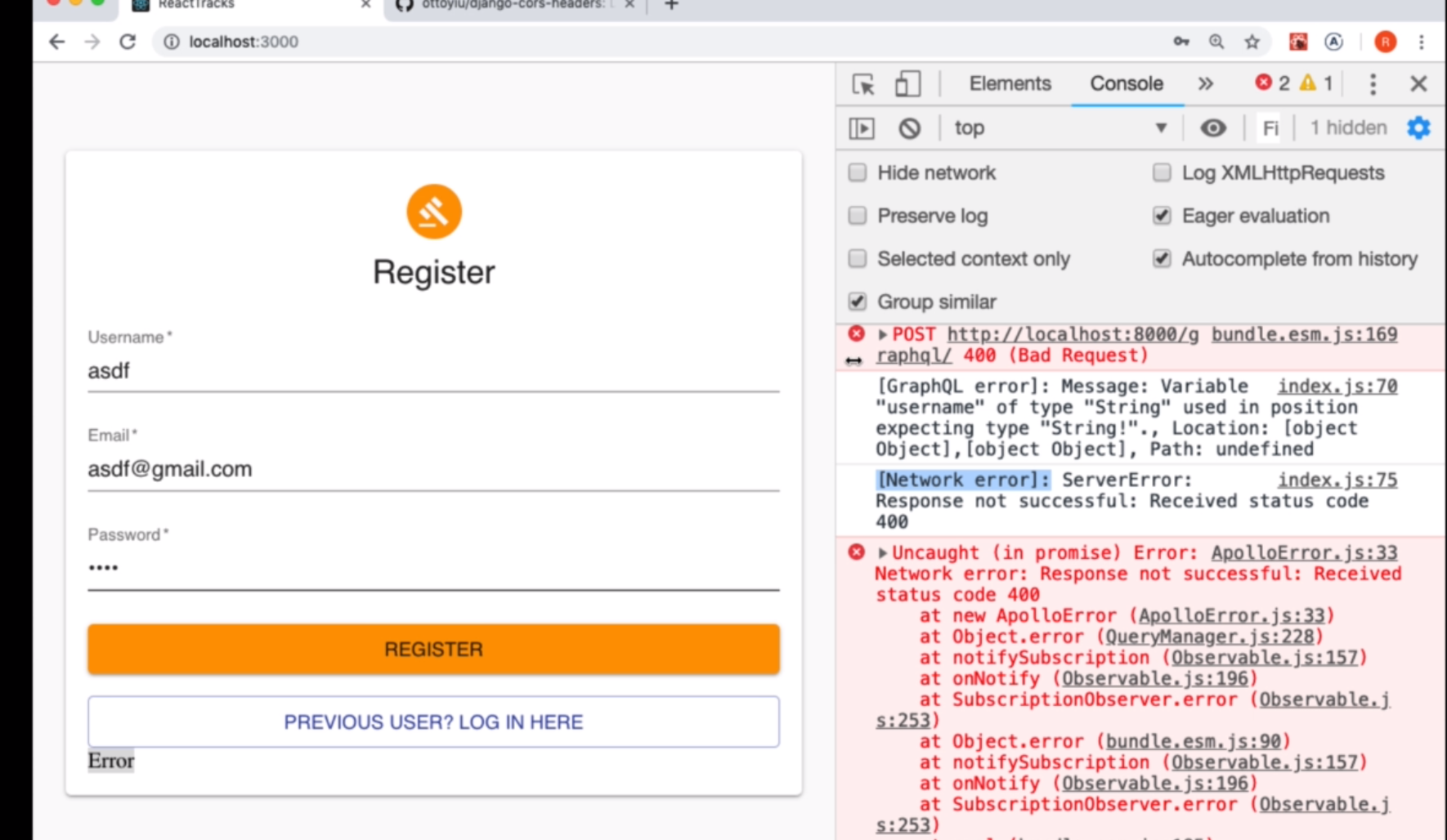
- After applying the changes.
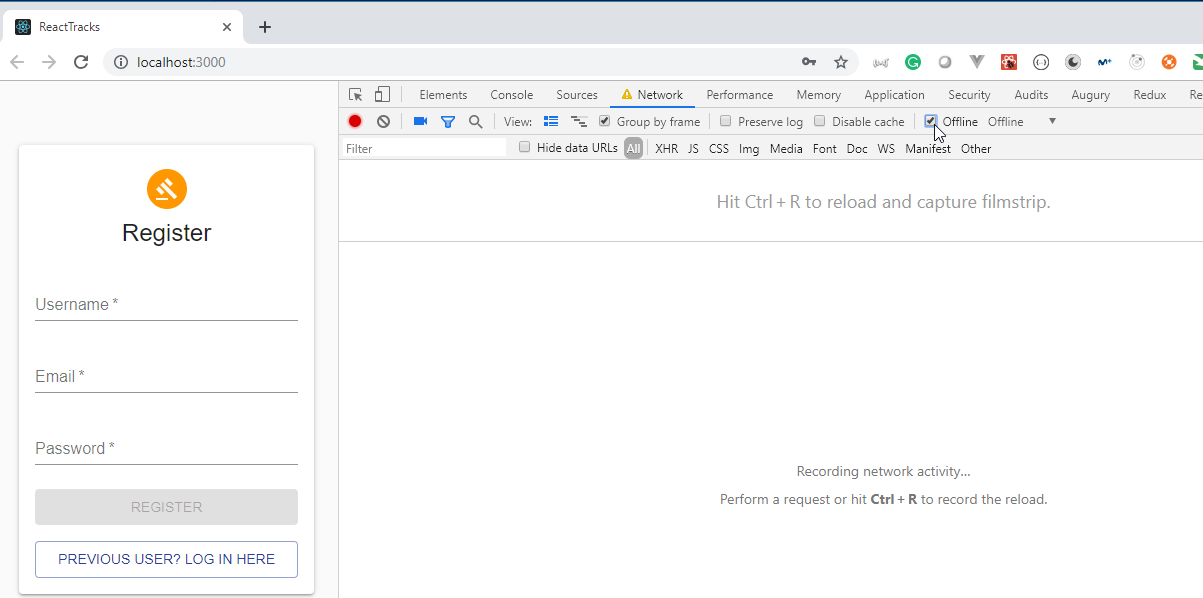

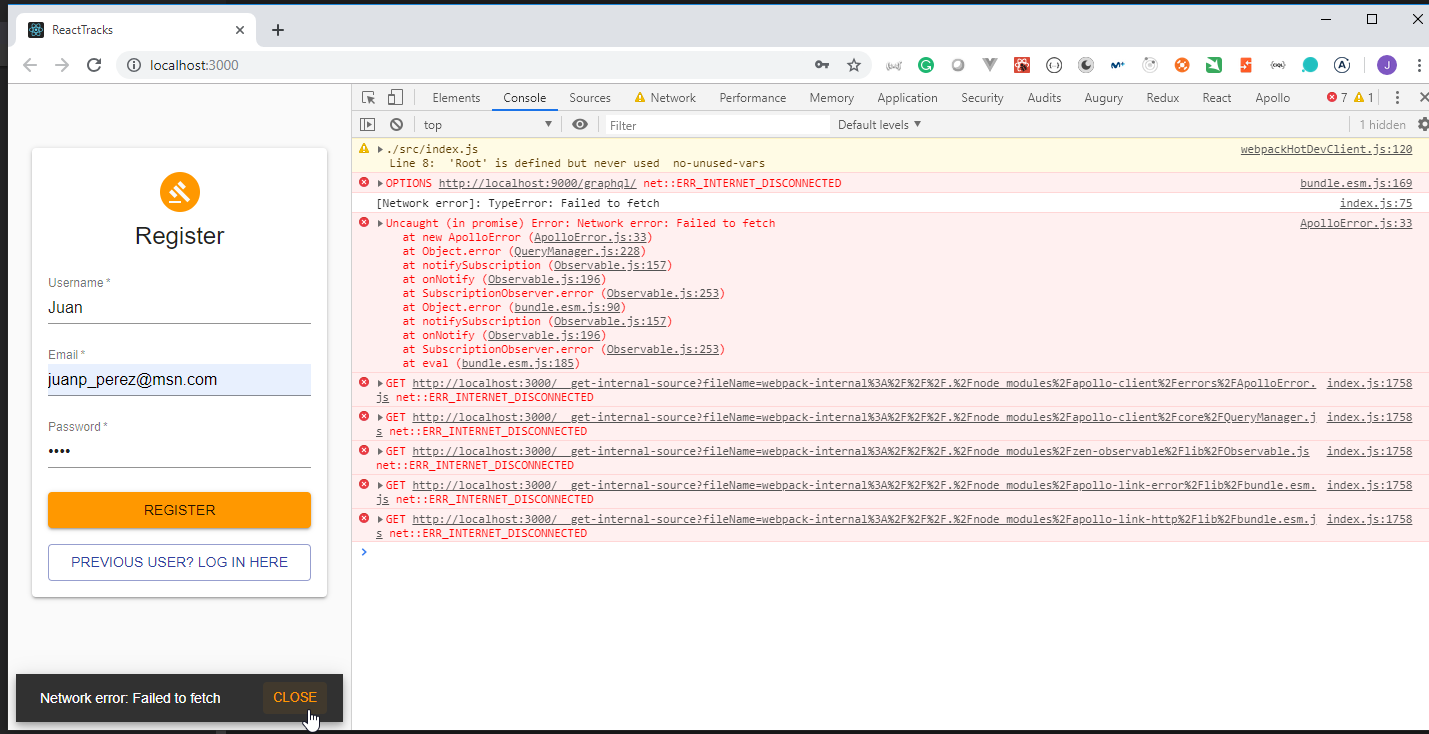
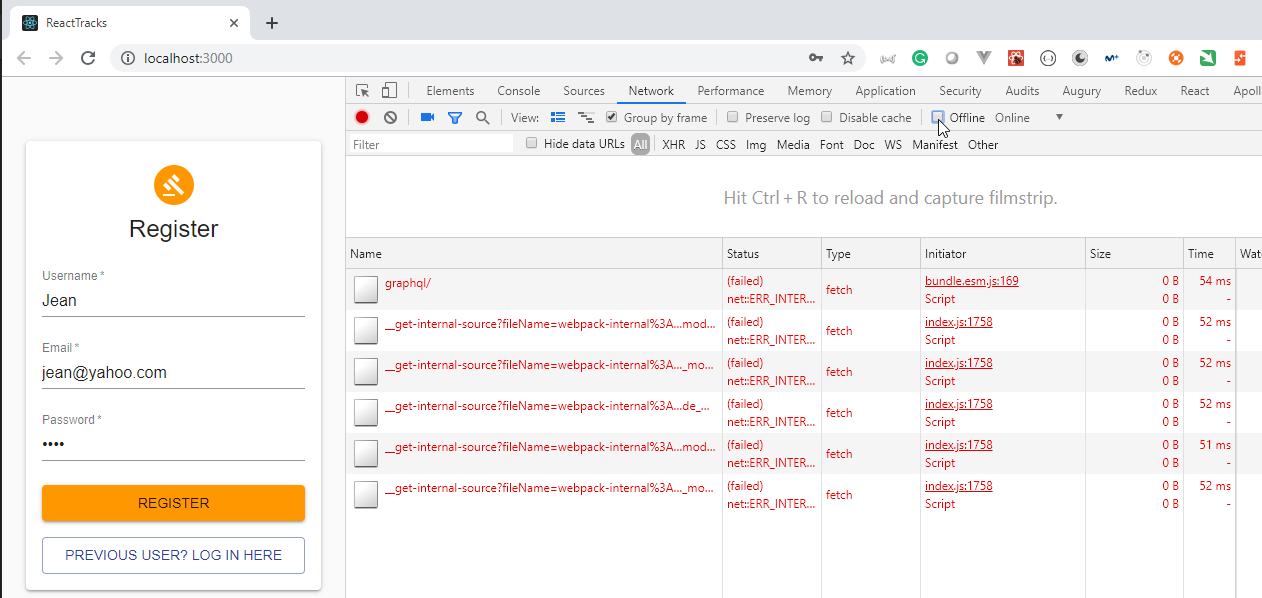
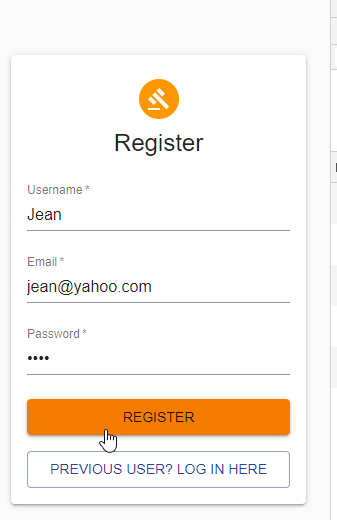
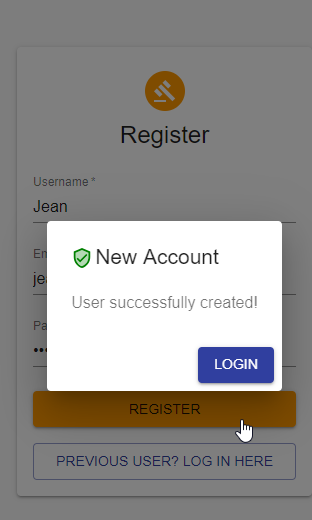
39. Build out Login Form / Execute Login Mutation for JWT 7min
- We are going to develop the
Auth/Logincomponent.
Auth/Login.js
import React, { useState } from "react";
import { Mutation } from "react-apollo";
import { gql } from "apollo-boost";
import withStyles from "@material-ui/core/styles/withStyles";
import Typography from "@material-ui/core/Typography";
import Avatar from "@material-ui/core/Avatar";
import FormControl from "@material-ui/core/FormControl";
import Paper from "@material-ui/core/Paper";
import Input from "@material-ui/core/Input";
import InputLabel from "@material-ui/core/InputLabel";
import Button from "@material-ui/core/Button";
import Lock from "@material-ui/icons/Lock";
import Error from "../Shared/Error";
const Login = ({ classes, setNewUser }) => {
const [username, setUsername] = useState("");
const [password, setPassword] = useState("");
const handleSubmit = (event, tokenAuth) => {
event.preventDefault();
tokenAuth();
};
return (
<div className={classes.root}>
<Paper className={classes.paper}>
<Avatar className={classes.avatar}>
<Lock />
</Avatar>
<Typography variant="title">Login as Existing User</Typography>
<Mutation
mutation={LOGIN_MUTATION}
variables={{ username, password }}
onCompleted={data => {
console.log({ data });
}}
>
{(tokenAuth, { loading, error }) => {
return (
<form
onSubmit={event => handleSubmit(event, tokenAuth)}
className={classes.form}
>
<FormControl margin="normal" required fullWidth>
<InputLabel htmlFor="username">Username</InputLabel>
<Input
id="username"
onChange={event => setUsername(event.target.value)}
/>
</FormControl>
<FormControl margin="normal" required fullWidth>
<InputLabel htmlFor="password">Password</InputLabel>
<Input
id="password"
type="password"
onChange={event => setPassword(event.target.value)}
/>
</FormControl>
<Button
type="submit"
fullWidth
variant="contained"
color="primary"
disabled={loading || !username.trim() || !password.trim()}
className={classes.submit}
>
{loading ? "Logging in..." : "Login"}
</Button>
<Button
onClick={() => setNewUser(true)}
color="secondary"
variant="outlined"
fullWidth
>
New user? Register here
</Button>
{/* Error Handling */}
{error && <Error error={error} />}
</form>
);
}}
</Mutation>
</Paper>
</div>
);
};
const LOGIN_MUTATION = gql`
mutation($username: String!, $password: String!) {
tokenAuth(username: $username, password: $password) {
token
}
}
`;
const styles = theme => ({
root: {
width: "auto",
display: "block",
marginLeft: theme.spacing.unit * 3,
marginRight: theme.spacing.unit * 3,
[theme.breakpoints.up("md")]: {
width: 400,
marginLeft: "auto",
marginRight: "auto"
}
},
paper: {
marginTop: theme.spacing.unit * 8,
display: "flex",
flexDirection: "column",
alignItems: "center",
padding: theme.spacing.unit * 2
},
title: {
marginTop: theme.spacing.unit * 2,
color: theme.palette.secondary.main
},
avatar: {
margin: theme.spacing.unit,
backgroundColor: theme.palette.primary.main
},
form: {
width: "100%",
marginTop: theme.spacing.unit
},
submit: {
marginTop: theme.spacing.unit * 2,
marginBottom: theme.spacing.unit * 2
}
});
export default withStyles(styles)(Login);
- We need to update
Auth/index.jsto include thesetNewUserparameter when calling theLogincomponent
Auth/index.js
import React, { useState } from "react";
import withRoot from "../../withRoot";
import Login from "./Login";
import Register from "./Register";
export default withRoot(() => {
const [newUser, setNewUser] = useState(true);
return newUser ? (
<Register setNewUser={setNewUser} />
) : (
<Login setNewUser={setNewUser} />
);
});
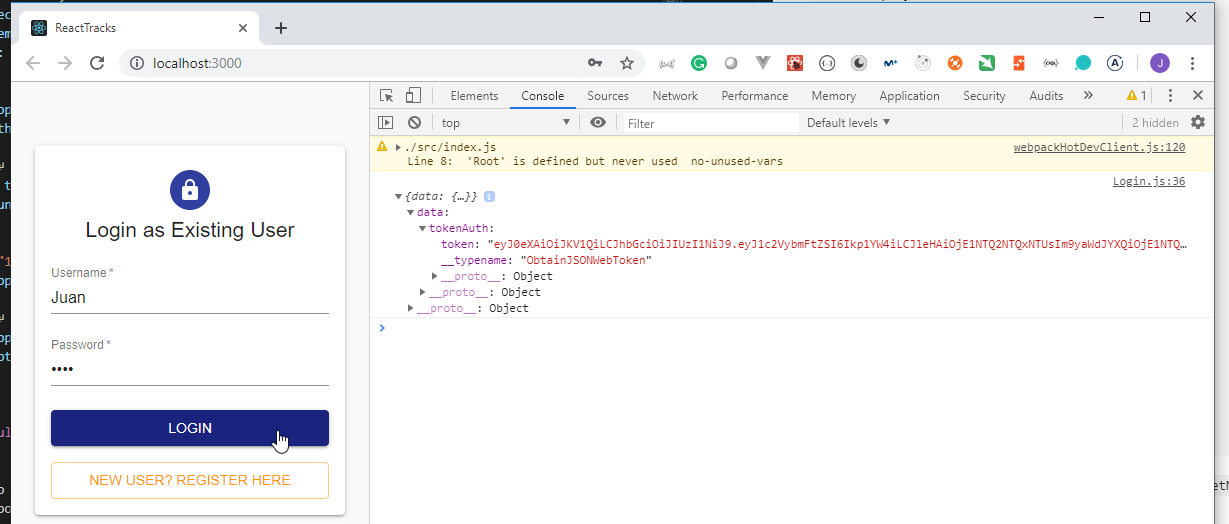
40. Using Apollo Client State to Manage Auth State 9min
- We need to modify the
Auth/Logincomponent to do two things:
- Go to the Home Page
- We need to provide the token on every request we make afterwords. In order to do this we are going to put the token on the browser
localStorage
Auth/Login.js
import React, { useState } from "react";
import { Mutation } from "react-apollo";
import { gql } from "apollo-boost";
import withStyles from "@material-ui/core/styles/withStyles";
import Typography from "@material-ui/core/Typography";
import Avatar from "@material-ui/core/Avatar";
import FormControl from "@material-ui/core/FormControl";
import Paper from "@material-ui/core/Paper";
import Input from "@material-ui/core/Input";
import InputLabel from "@material-ui/core/InputLabel";
import Button from "@material-ui/core/Button";
import Lock from "@material-ui/icons/Lock";
import Error from "../Shared/Error";
const Login = ({ classes, setNewUser }) => {
const [username, setUsername] = useState("");
const [password, setPassword] = useState("");
const handleSubmit = async (event, tokenAuth) => {
event.preventDefault();
const res = await tokenAuth();
localStorage.setItem("authToken", res.data.tokenAuth.token);
};
return (
<div className={classes.root}>
<Paper className={classes.paper}>
<Avatar className={classes.avatar}>
<Lock />
</Avatar>
<Typography variant="title">Login as Existing User</Typography>
<Mutation mutation={LOGIN_MUTATION} variables={{ username, password }}>
{(tokenAuth, { loading, error }) => {
return (
<form
onSubmit={event => handleSubmit(event, tokenAuth)}
className={classes.form}
>
<FormControl margin="normal" required fullWidth>
<InputLabel htmlFor="username">Username</InputLabel>
<Input
id="username"
onChange={event => setUsername(event.target.value)}
/>
</FormControl>
<FormControl margin="normal" required fullWidth>
<InputLabel htmlFor="password">Password</InputLabel>
<Input
id="password"
type="password"
onChange={event => setPassword(event.target.value)}
/>
</FormControl>
<Button
type="submit"
fullWidth
variant="contained"
color="primary"
disabled={loading || !username.trim() || !password.trim()}
className={classes.submit}
>
{loading ? "Logging in..." : "Login"}
</Button>
<Button
onClick={() => setNewUser(true)}
color="secondary"
variant="outlined"
fullWidth
>
New user? Register here
</Button>
{/* Error Handling */}
{error && <Error error={error} />}
</form>
);
}}
</Mutation>
</Paper>
</div>
);
};
const LOGIN_MUTATION = gql`
mutation($username: String!, $password: String!) {
tokenAuth(username: $username, password: $password) {
token
}
}
`;
const styles = theme => ({
root: {
width: "auto",
display: "block",
marginLeft: theme.spacing.unit * 3,
marginRight: theme.spacing.unit * 3,
[theme.breakpoints.up("md")]: {
width: 400,
marginLeft: "auto",
marginRight: "auto"
}
},
paper: {
marginTop: theme.spacing.unit * 8,
display: "flex",
flexDirection: "column",
alignItems: "center",
padding: theme.spacing.unit * 2
},
title: {
marginTop: theme.spacing.unit * 2,
color: theme.palette.secondary.main
},
avatar: {
margin: theme.spacing.unit,
backgroundColor: theme.palette.primary.main
},
form: {
width: "100%",
marginTop: theme.spacing.unit
},
submit: {
marginTop: theme.spacing.unit * 2,
marginBottom: theme.spacing.unit * 2
}
});
export default withStyles(styles)(Login);
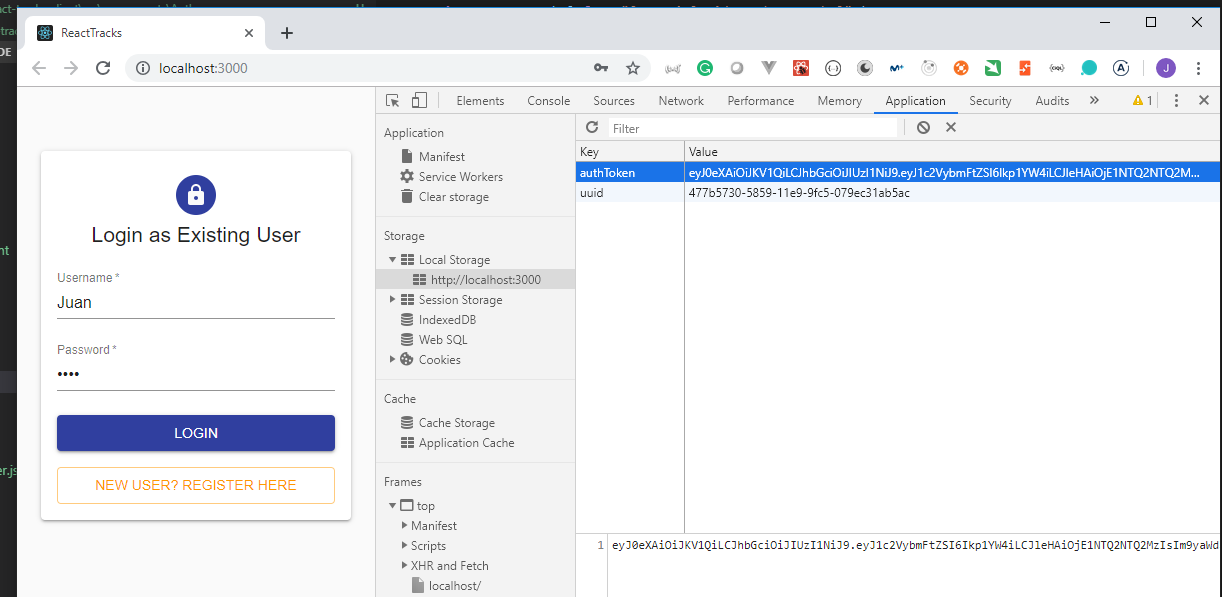
- We need to modify main
index.jsdocument to do two things:
- Set up a new Apollo client called
clientStatethat is going to be available for every component in our app. So our state is going to be managed by this client State. We are going to store the authorication token there. - Access the Apollo client to check if the user has an user authentication token stored there. If there is one it is going to redirect to the
Rootpage, otherwise to theAuthpage.
index.js
import React from "react";
import ReactDOM from "react-dom";
import * as serviceWorker from "./serviceWorker";
import { ApolloProvider, Query } from "react-apollo";
import ApolloClient, { gql } from "apollo-boost";
import Root from "./Root";
import Auth from "./components/Auth";
const client = new ApolloClient({
uri: "http://localhost:9000/graphql/",
clientState: {
defaults: {
isLoggedIn: !!localStorage.getItem("authToken")
}
}
});
const IS_LOGGED_IN_QUERY = gql`
query {
isLoggedIn @client
}
`;
ReactDOM.render(
<ApolloProvider client={client}>
<Query query={IS_LOGGED_IN_QUERY}>
{({ data }) => (data.isLoggedIn ? <Root /> : <Auth />)}
</Query>
</ApolloProvider>,
document.getElementById("root")
);
// If you want your app to work offline and load faster, you can change
// unregister() to register() below. Note this comes with some pitfalls.
// Learn more about service workers: http://bit.ly/CRA-PWA
serviceWorker.unregister();
- We need to modify the
Auth/Logincomponent again to do another two things:
- Modify the mutation to get access to the
clientState - Set the
isLoggedInvalue to true when the user is authenticathed.
Auth/Login.js
import React, { useState } from "react";
import { Mutation } from "react-apollo";
import { gql } from "apollo-boost";
import withStyles from "@material-ui/core/styles/withStyles";
import Typography from "@material-ui/core/Typography";
import Avatar from "@material-ui/core/Avatar";
import FormControl from "@material-ui/core/FormControl";
import Paper from "@material-ui/core/Paper";
import Input from "@material-ui/core/Input";
import InputLabel from "@material-ui/core/InputLabel";
import Button from "@material-ui/core/Button";
import Lock from "@material-ui/icons/Lock";
import Error from "../Shared/Error";
const Login = ({ classes, setNewUser }) => {
const [username, setUsername] = useState("");
const [password, setPassword] = useState("");
const handleSubmit = async (event, tokenAuth, client) => {
event.preventDefault();
const res = await tokenAuth();
localStorage.setItem("authToken", res.data.tokenAuth.token);
client.writeData({ data: { isLoggedIn: true } });
};
return (
<div className={classes.root}>
<Paper className={classes.paper}>
<Avatar className={classes.avatar}>
<Lock />
</Avatar>
<Typography variant="title">Login as Existing User</Typography>
<Mutation mutation={LOGIN_MUTATION} variables={{ username, password }}>
{/*
called: it returns true if the mutation has been executed
client: client object
*/}
{(tokenAuth, { loading, error, called, client }) => {
return (
<form
onSubmit={event => handleSubmit(event, tokenAuth, client)}
className={classes.form}
>
<FormControl margin="normal" required fullWidth>
<InputLabel htmlFor="username">Username</InputLabel>
<Input
id="username"
onChange={event => setUsername(event.target.value)}
/>
</FormControl>
<FormControl margin="normal" required fullWidth>
<InputLabel htmlFor="password">Password</InputLabel>
<Input
id="password"
type="password"
onChange={event => setPassword(event.target.value)}
/>
</FormControl>
<Button
type="submit"
fullWidth
variant="contained"
color="primary"
disabled={loading || !username.trim() || !password.trim()}
className={classes.submit}
>
{loading ? "Logging in..." : "Login"}
</Button>
<Button
onClick={() => setNewUser(true)}
color="secondary"
variant="outlined"
fullWidth
>
New user? Register here
</Button>
{/* Error Handling */}
{error && <Error error={error} />}
</form>
);
}}
</Mutation>
</Paper>
</div>
);
};
const LOGIN_MUTATION = gql`
mutation($username: String!, $password: String!) {
tokenAuth(username: $username, password: $password) {
token
}
}
`;
const styles = theme => ({
root: {
width: "auto",
display: "block",
marginLeft: theme.spacing.unit * 3,
marginRight: theme.spacing.unit * 3,
[theme.breakpoints.up("md")]: {
width: 400,
marginLeft: "auto",
marginRight: "auto"
}
},
paper: {
marginTop: theme.spacing.unit * 8,
display: "flex",
flexDirection: "column",
alignItems: "center",
padding: theme.spacing.unit * 2
},
title: {
marginTop: theme.spacing.unit * 2,
color: theme.palette.secondary.main
},
avatar: {
margin: theme.spacing.unit,
backgroundColor: theme.palette.primary.main
},
form: {
width: "100%",
marginTop: theme.spacing.unit
},
submit: {
marginTop: theme.spacing.unit * 2,
marginBottom: theme.spacing.unit * 2
}
});
export default withStyles(styles)(Login);
- If we refresh the page, as there is a token in the Apollo Client, it is redirect to the
Rootpage.

41. Adding JWT to our Authorization Header with Apollo Client 4min
- We need to modify main
index.jsdocument to set the authentication token to the header when we make GraphQl calls.
index.js
import React from "react";
import ReactDOM from "react-dom";
import * as serviceWorker from "./serviceWorker";
import { ApolloProvider, Query } from "react-apollo";
import ApolloClient, { gql } from "apollo-boost";
import Root from "./Root";
import Auth from "./components/Auth";
const client = new ApolloClient({
uri: "http://localhost:9000/graphql/",
// When we make a fetch we will send credentials
fetchOptions: {
credentials: "include"
},
// operation allow as to access the header
request: operation => {
const token = localStorage.getItem("authToken") || "";
operation.setContext({
headers: {
Authorization: `JWT ${token}`
}
});
},
clientState: {
defaults: {
isLoggedIn: !!localStorage.getItem("authToken")
}
}
});
const IS_LOGGED_IN_QUERY = gql`
query {
isLoggedIn @client
}
`;
ReactDOM.render(
<ApolloProvider client={client}>
<Query query={IS_LOGGED_IN_QUERY}>
{({ data }) => (data.isLoggedIn ? <Root /> : <Auth />)}
</Query>
</ApolloProvider>,
document.getElementById("root")
);
// If you want your app to work offline and load faster, you can change
// unregister() to register() below. Note this comes with some pitfalls.
// Learn more about service workers: http://bit.ly/CRA-PWA
serviceWorker.unregister();
- In order to test if the authentication is working we are going to change the query we use on the
Rootpage for one that needs authentication to be executed.
Root.js
import React from "react";
import withRoot from "./withRoot";
import { Query } from "react-apollo";
import { gql } from "apollo-boost";
const Root = () => (
<Query query={ME_QUERY}>
{({ data, loading, error }) => {
if (loading) return <div>Loading</div>;
if (error) return <div>Error</div>;
return <div>{JSON.stringify(data)}</div>;
}}
</Query>
);
export const ME_QUERY = gql`
{
me {
id
username
email
}
}
`;
// const GET_TRACKS_QUERY = gql`
// {
// tracks {
// id
// title
// description
// url
// }
// }
// `;
export default withRoot(Root);
- If we refresh the page we can see the
mequery is executed correctly.

- And if we remove the
authTokenfrom theLocalStorageand refresh the page it is redirected to theRegisterpage.
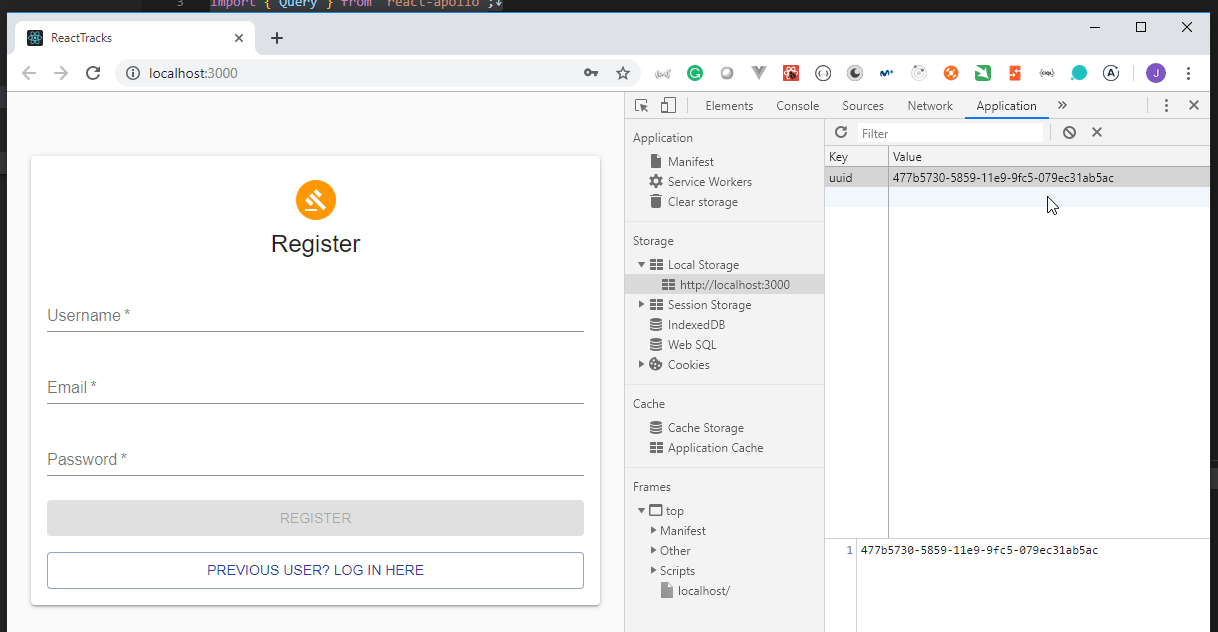
- And if we log in again we another user we can see the information of this other user.

42. Adding Routing with React Router 4 5min
- We need to modify the
Rootpage to manage therouting. We are going to use theReact Router DOM
Root.js
import React from "react";
import { Query } from "react-apollo";
import { gql } from "apollo-boost";
import { BrowserRouter as Router, Switch, Route } from "react-router-dom";
import withRoot from "./withRoot";
import App from "./pages/App";
import Profile from "./pages/Profile";
const Root = () => (
<Query query={ME_QUERY}>
{({ data, loading, error }) => {
if (loading) return <div>Loading</div>;
if (error) return <div>Error</div>;
return (
<Router>
<Switch>
<Route exact path="/" component={App} />
<Route path="/profile/:id" component={Profile} />
</Switch>
</Router>
);
}}
</Query>
);
export const ME_QUERY = gql`
{
me {
id
username
email
}
}
`;
// const GET_TRACKS_QUERY = gql`
// {
// tracks {
// id
// title
// description
// url
// }
// }
// `;
export default withRoot(Root);
pages/App.js
import React from "react";
import withStyles from "@material-ui/core/styles/withStyles";
const App = ({ classes }) => {
return <div>App</div>;
};
const styles = theme => ({
container: {
margin: "0 auto",
maxWidth: 960,
padding: theme.spacing.unit * 2
}
});
export default withStyles(styles)(App);
pages/Profile.js
import React from "react";
import withStyles from "@material-ui/core/styles/withStyles";
// import Card from "@material-ui/core/Card";
// import CardHeader from "@material-ui/core/CardHeader";
// import Avatar from "@material-ui/core/Avatar";
// import Paper from "@material-ui/core/Paper";
// import Typography from "@material-ui/core/Typography";
// import ThumbUpIcon from "@material-ui/icons/ThumbUpTwoTone";
// import AudiotrackIcon from "@material-ui/icons/AudiotrackTwoTone";
// import Divider from "@material-ui/core/Divider";
const Profile = ({ classes }) => {
return <div>Profile</div>;
};
const styles = theme => ({
paper: {
width: "auto",
display: "block",
padding: theme.spacing.unit * 2,
marginLeft: theme.spacing.unit * 3,
marginRight: theme.spacing.unit * 3,
marginTop: theme.spacing.unit * 2,
marginBottom: theme.spacing.unit * 2,
[theme.breakpoints.up("md")]: {
width: 650,
marginLeft: "auto",
marginRight: "auto"
}
},
card: {
display: "flex",
justifyContent: "center"
},
title: {
display: "flex",
alignItems: "center",
marginBottom: theme.spacing.unit * 2
},
audioIcon: {
color: "purple",
fontSize: 30,
marginRight: theme.spacing.unit
},
thumbIcon: {
color: "green",
marginRight: theme.spacing.unit
},
divider: {
marginTop: theme.spacing.unit,
marginBottom: theme.spacing.unit
}
});
export default withStyles(styles)(Profile);
- So, we can check the routing works.
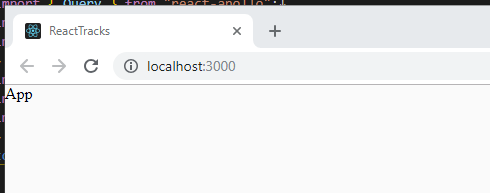
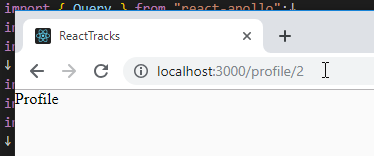
- We need to modify the
Rootpage to include theHeadercomponent.
components/Shared/Header.js
import React from "react";
import withStyles from "@material-ui/core/styles/withStyles";
// import AppBar from "@material-ui/core/AppBar";
// import Toolbar from "@material-ui/core/Toolbar";
// import RadioIcon from "@material-ui/icons/RadioTwoTone";
// import FaceIcon from "@material-ui/icons/FaceTwoTone";
// import Typography from "@material-ui/core/Typography";
const Header = ({ classes }) => {
return <div>Header</div>;
};
const styles = theme => ({
root: {
flexGrow: 1,
margin: 0,
padding: 0
},
grow: {
flexGrow: 1,
display: "flex",
alignItems: "center",
textDecoration: "none"
},
logo: {
marginRight: theme.spacing.unit,
fontSize: 45
},
faceIcon: {
marginRight: theme.spacing.unit,
fontSize: 30,
color: "white"
},
username: {
color: "white",
fontSize: 30
}
});
export default withStyles(styles)(Header);
Root.js
import React from "react";
import { Query } from "react-apollo";
import { gql } from "apollo-boost";
import { BrowserRouter as Router, Switch, Route } from "react-router-dom";
import withRoot from "./withRoot";
import App from "./pages/App";
import Profile from "./pages/Profile";
import Header from "./components/Shared/Header";
const Root = () => (
<Query query={ME_QUERY}>
{({ data, loading, error }) => {
if (loading) return <div>Loading</div>;
if (error) return <div>Error</div>;
return (
<Router>
<>
<Header />
<Switch>
<Route exact path="/" component={App} />
<Route path="/profile/:id" component={Profile} />
</Switch>
</>
</Router>
);
}}
</Query>
);
export const ME_QUERY = gql`
{
me {
id
username
email
}
}
`;
// const GET_TRACKS_QUERY = gql`
// {
// tracks {
// id
// title
// description
// url
// }
// }
// `;
export default withRoot(Root);
- We can see now that the
Headercomponent is on top of theAppandProfilepages.
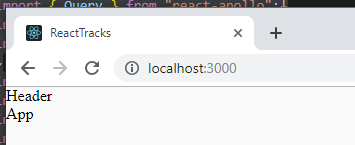
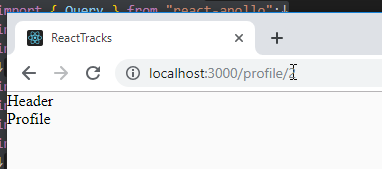
43. Styling our Header 6min
- We are going to update the
Shared/Header.jscomponent to style the header, theRootpage to send the client data to the Header component and theAuth/Signout.jscomponent used to sign out from the app.
Auth/Signout.js
import React from "react";
import withStyles from "@material-ui/core/styles/withStyles";
import ExitToApp from "@material-ui/icons/ExitToApp";
import Typography from "@material-ui/core/Typography";
import Button from "@material-ui/core/Button";
const Signout = ({ classes }) => {
return (
<Button>
<Typography
variant="body1"
className={classes.buttonText}
color="secondary"
>
Signout
</Typography>
<ExitToApp className={classes.buttonIcon} color="secondary" />
</Button>
);
};
const styles = {
root: {
cursor: "pointer",
display: "flex"
},
buttonIcon: {
marginLeft: "5px"
}
};
export default withStyles(styles)(Signout);
Root.js
import React from "react";
import { Query } from "react-apollo";
import { gql } from "apollo-boost";
import { BrowserRouter as Router, Switch, Route } from "react-router-dom";
import withRoot from "./withRoot";
import App from "./pages/App";
import Profile from "./pages/Profile";
import Header from "./components/Shared/Header";
const Root = () => (
<Query query={ME_QUERY}>
{({ data, loading, error }) => {
if (loading) return <div>Loading</div>;
if (error) return <div>Error</div>;
const currentUser = data.me;
return (
<Router>
<>
<Header currentUser={currentUser} />
<Switch>
<Route exact path="/" component={App} />
<Route path="/profile/:id" component={Profile} />
</Switch>
</>
</Router>
);
}}
</Query>
);
export const ME_QUERY = gql`
{
me {
id
username
email
}
}
`;
// const GET_TRACKS_QUERY = gql`
// {
// tracks {
// id
// title
// description
// url
// }
// }
// `;
export default withRoot(Root);
Shared/Header.js
import React from "react";
import withStyles from "@material-ui/core/styles/withStyles";
import AppBar from "@material-ui/core/AppBar";
import Toolbar from "@material-ui/core/Toolbar";
import RadioIcon from "@material-ui/icons/RadioTwoTone";
import FaceIcon from "@material-ui/icons/FaceTwoTone";
import Typography from "@material-ui/core/Typography";
import { Link } from "react-router-dom";
import Signout from "../Auth/Signout";
const Header = ({ classes, currentUser }) => {
return (
<AppBar position="static" className={classes.root}>
<Toolbar>
{/* Title / Logo */}
<Link to="/" className={classes.grow}>
<RadioIcon className={classes.logo} color="secondary" />
<Typography variant="headline" color="secondary" noWrap>
ReactTracks
</Typography>
</Link>
{/* Auth User Info */}
{currentUser && (
<Link to={`/profile/${currentUser.id}`} className={classes.grow}>
<FaceIcon className={classes.faceIcon} />
<Typography variant="headline" className={classes.username} noWrap>
{currentUser.username}
</Typography>
</Link>
)}
{/* Signout Button */}
<Signout />
</Toolbar>
</AppBar>
);
};
const styles = theme => ({
root: {
flexGrow: 1,
margin: 0,
padding: 0
},
grow: {
flexGrow: 1,
display: "flex",
alignItems: "center",
textDecoration: "none"
},
logo: {
marginRight: theme.spacing.unit,
fontSize: 45
},
faceIcon: {
marginRight: theme.spacing.unit,
fontSize: 30,
color: "white"
},
username: {
color: "white",
fontSize: 30
}
});
export default withStyles(styles)(Header);
- If we run the app we can see how the header looks like:
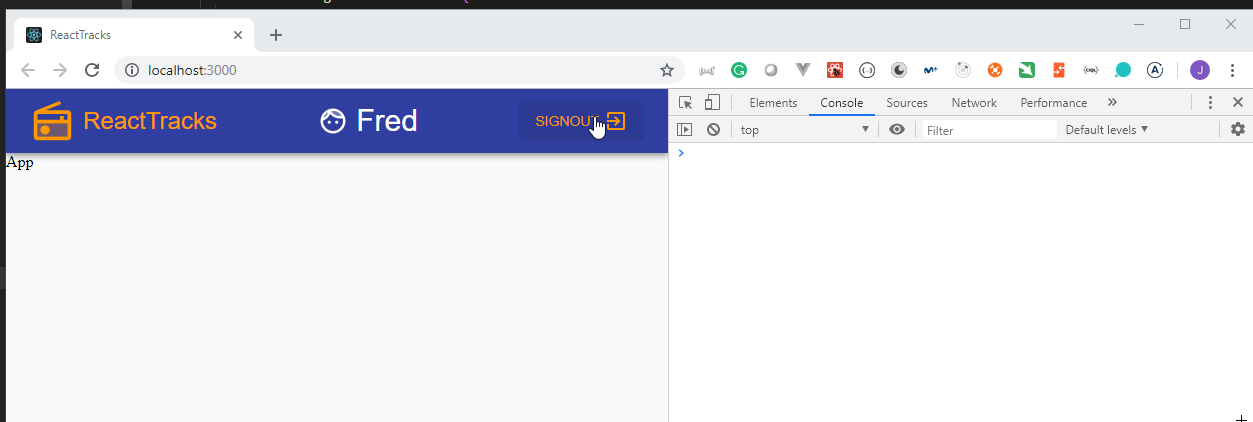


44. Signing Out Users with Signout Button 5min
We are going to update the
Auth/Signout.jscomponent to finish the Sign Out feauture.We want to do two things:
- Remove the token from the
LocalStorage - Update the
isLoggedInproperty from theApollo Client Stateto false.
Auth/Signout.js
import React from "react";
import { ApolloConsumer } from "react-apollo";
import withStyles from "@material-ui/core/styles/withStyles";
import ExitToApp from "@material-ui/icons/ExitToApp";
import Typography from "@material-ui/core/Typography";
import Button from "@material-ui/core/Button";
const Signout = ({ classes }) => {
const handleSignout = client => {
localStorage.removeItem("authToken");
client.writeData({ data: { isLoggedIn: false } });
console.log("Signed out user", client);
};
return (
<ApolloConsumer>
{client => (
<Button onClick={() => handleSignout(client)}>
<Typography
variant="body1"
className={classes.buttonText}
color="secondary"
>
Signout
</Typography>
<ExitToApp className={classes.buttonIcon} color="secondary" />
</Button>
)}
</ApolloConsumer>
);
};
const styles = {
root: {
cursor: "pointer",
display: "flex"
},
buttonIcon: {
marginLeft: "5px"
}
};
export default withStyles(styles)(Signout);
- If we click now on the
SIGNOUTbutton we can see the token is removed from theLocalStorageand it is redirect to theRegisterpage.
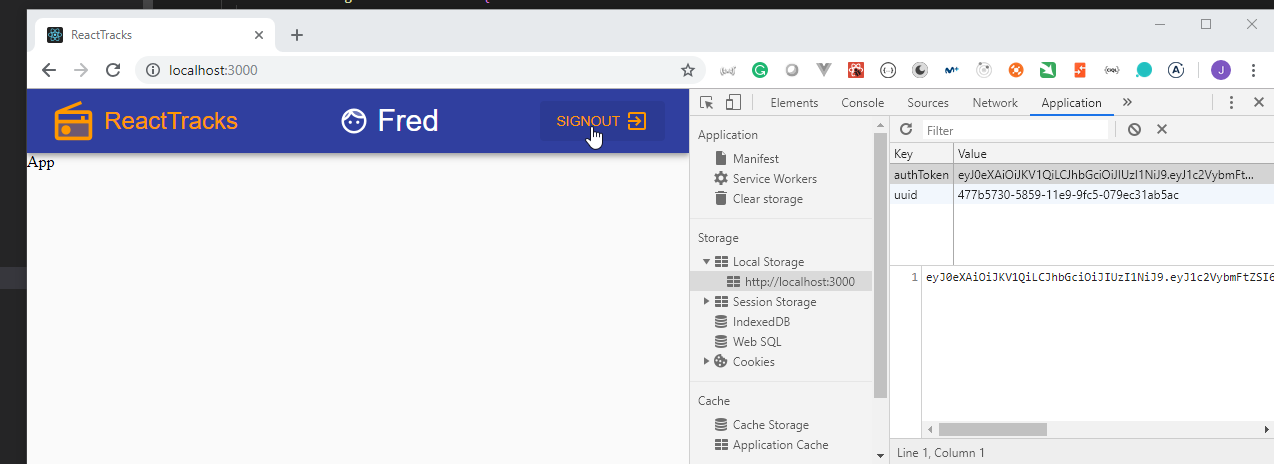
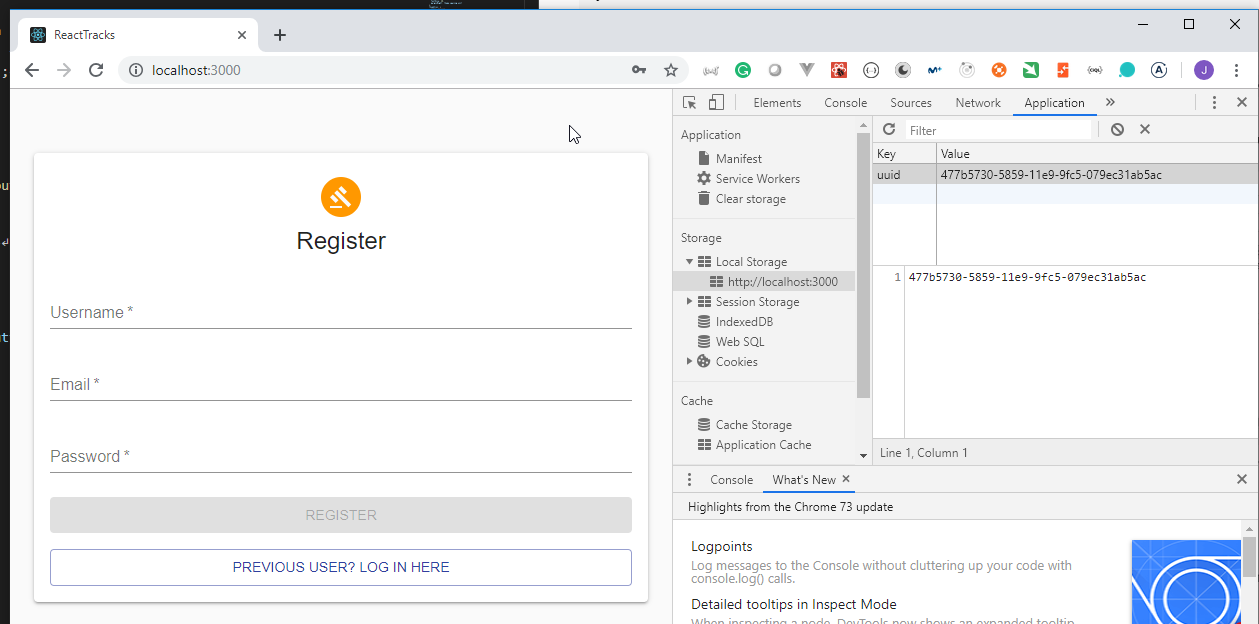
45. Creating Loading Component 3min
- If we load the page we can see the
Loadingtext.

- We are going to finish the
Shared/Loadingcomponent that will be shown instead of the text, theRootpage will be changed to use it.
Root.js
import React from "react";
import { Query } from "react-apollo";
import { gql } from "apollo-boost";
import { BrowserRouter as Router, Switch, Route } from "react-router-dom";
import withRoot from "./withRoot";
import App from "./pages/App";
import Profile from "./pages/Profile";
import Header from "./components/Shared/Header";
import Loading from "./components/Shared/Loading";
import Error from "./components/Shared/Error";
const Root = () => (
<Query query={ME_QUERY}>
{({ data, loading, error }) => {
if (loading) return <Loading />;
if (error) return <Error error={error} />;
const currentUser = data.me;
return (
<Router>
<>
<Header currentUser={currentUser} />
<Switch>
<Route exact path="/" component={App} />
<Route path="/profile/:id" component={Profile} />
</Switch>
</>
</Router>
);
}}
</Query>
);
export const ME_QUERY = gql`
{
me {
id
username
email
}
}
`;
// const GET_TRACKS_QUERY = gql`
// {
// tracks {
// id
// title
// description
// url
// }
// }
// `;
export default withRoot(Root);
Shared/Loading.js
import React from "react";
import withStyles from "@material-ui/core/styles/withStyles";
import CircularProgress from "@material-ui/core/CircularProgress";
const Loading = ({ classes }) => (
<div className={classes.root}>
<CircularProgress className={classes.progress} />
</div>
);
const styles = theme => ({
root: {
width: "100vw",
textAlign: "center"
},
progress: {
margin: theme.spacing.unit * 2,
color: theme.palette.secondary.dark
}
});
export default withStyles(styles)(Loading);
- We are going to test it by setting the Network to
Fast 3Gand refreshing the page.


46. Displaying Tracks with Track List 15min
We are going to finish the
pages/Apppage to put a search bar, a list with the tracks and for each tarck it will be possible to like the track, see the track details, play the track and if the user has created the track it could be edited and deleted. There will also be a button that will open a dialog to create new tracks.The following components will be included
components/Track/SearchTracks.js
import React from "react";
import withStyles from "@material-ui/core/styles/withStyles";
// import TextField from "@material-ui/core/TextField";
// import ClearIcon from "@material-ui/icons/Clear";
// import Paper from "@material-ui/core/Paper";
// import IconButton from "@material-ui/core/IconButton";
// import SearchIcon from "@material-ui/icons/Search";
const SearchTracks = ({ classes }) => {
return <div>SearchTracks</div>;
};
const styles = theme => ({
root: {
padding: "2px 4px",
margin: theme.spacing.unit,
display: "flex",
alignItems: "center"
}
});
export default withStyles(styles)(SearchTracks);
components/Track/TrackList.js
import React from "react";
import withStyles from "@material-ui/core/styles/withStyles";
// import List from "@material-ui/core/List";
// import ListItem from "@material-ui/core/ListItem";
// import ListItemText from "@material-ui/core/ListItemText";
// import Typography from "@material-ui/core/Typography";
// import ExpansionPanel from "@material-ui/core/ExpansionPanel";
// import ExpansionPanelDetails from "@material-ui/core/ExpansionPanelDetails";
// import ExpansionPanelSummary from "@material-ui/core/ExpansionPanelSummary";
// import ExpansionPanelActions from "@material-ui/core/ExpansionPanelActions";
// import ExpandMoreIcon from "@material-ui/icons/ExpandMore";
const TrackList = ({ classes }) => <div>TrackList</div>;
const styles = {
root: {
display: "flex",
flexWrap: "wrap"
},
details: {
alignItems: "center"
},
link: {
color: "#424242",
textDecoration: "none",
"&:hover": {
color: "black"
}
}
};
export default withStyles(styles)(TrackList);
components/Track/CreateTrack.js
import React from "react";
import withStyles from "@material-ui/core/styles/withStyles";
// import Dialog from "@material-ui/core/Dialog";
// import DialogActions from "@material-ui/core/DialogActions";
// import DialogContent from "@material-ui/core/DialogContent";
// import DialogContentText from "@material-ui/core/DialogContentText";
// import DialogTitle from "@material-ui/core/DialogTitle";
// import FormControl from "@material-ui/core/FormControl";
// import FormHelperText from "@material-ui/core/FormHelperText";
// import TextField from "@material-ui/core/TextField";
// import Button from "@material-ui/core/Button";
// import CircularProgress from "@material-ui/core/CircularProgress";
// import AddIcon from "@material-ui/icons/Add";
// import ClearIcon from "@material-ui/icons/Clear";
// import LibraryMusicIcon from "@material-ui/icons/LibraryMusic";
const CreateTrack = ({ classes }) => {
return <div>CreateTrack</div>;
};
const styles = theme => ({
container: {
display: "flex",
flexWrap: "wrap"
},
dialog: {
margin: "0 auto",
maxWidth: 550
},
textField: {
margin: theme.spacing.unit
},
cancel: {
color: "red"
},
save: {
color: "green"
},
button: {
margin: theme.spacing.unit * 2
},
icon: {
marginLeft: theme.spacing.unit
},
input: {
display: "none"
},
fab: {
position: "fixed",
bottom: theme.spacing.unit * 2,
right: theme.spacing.unit * 2,
zIndex: "200"
}
});
export default withStyles(styles)(CreateTrack);
pages/App.js
import React from "react";
import withStyles from "@material-ui/core/styles/withStyles";
import SearchTracks from "../components/Track/SearchTracks";
import TrackList from "../components/Track/TrackList";
import CreateTrack from "../components/Track/CreateTrack";
const App = ({ classes }) => {
return (
<div className={classes.container}>
<SearchTracks />
<CreateTrack />
<TrackList />
</div>
);
};
const styles = theme => ({
container: {
margin: "0 auto",
maxWidth: 960,
padding: theme.spacing.unit * 2
}
});
export default withStyles(styles)(App);

- We need to modify the
pages/Apppage and thecomponents/Track/TrackListcomponents to obtain the list of tracks.
The TrackList component is going to use the following components:
components/Shared/AudioPlayer.js
import React from "react";
const AudioPlayer = () => <div>AudioPlayer</div>;
export default AudioPlayer;
components/Track/LikeTrack.js
import React from "react";
import withStyles from "@material-ui/core/styles/withStyles";
// import IconButton from "@material-ui/core/IconButton";
// import ThumbUpIcon from "@material-ui/icons/ThumbUp";
const LikeTrack = ({ classes }) => {
return <div>LikeTrack</div>;
};
const styles = theme => ({
iconButton: {
color: "deeppink"
},
icon: {
marginLeft: theme.spacing.unit / 2
}
});
export default withStyles(styles)(LikeTrack);
components/Track/DeleteTrack.js
import React from "react";
// import IconButton from "@material-ui/core/IconButton";
// import TrashIcon from "@material-ui/icons/DeleteForeverOutlined";
const DeleteTrack = () => {
return <div>DeleteTrack</div>;
};
export default DeleteTrack;
components/Track/UpdateTrack.js
import React from "react";
import withStyles from "@material-ui/core/styles/withStyles";
// import IconButton from "@material-ui/core/IconButton";
// import EditIcon from "@material-ui/icons/Edit";
// import Button from "@material-ui/core/Button";
// import TextField from "@material-ui/core/TextField";
// import Dialog from "@material-ui/core/Dialog";
// import DialogActions from "@material-ui/core/DialogActions";
// import DialogContent from "@material-ui/core/DialogContent";
// import DialogContentText from "@material-ui/core/DialogContentText";
// import FormControl from "@material-ui/core/FormControl";
// import FormHelperText from "@material-ui/core/FormHelperText";
// import DialogTitle from "@material-ui/core/DialogTitle";
// import CircularProgress from "@material-ui/core/CircularProgress";
// import LibraryMusicIcon from "@material-ui/icons/LibraryMusic";
const UpdateTrack = ({ classes }) => {
return <div>UpdateTrack</div>;
};
const styles = theme => ({
container: {
display: "flex",
flexWrap: "wrap"
},
dialog: {
margin: "0 auto",
maxWidth: 550
},
textField: {
margin: theme.spacing.unit
},
cancel: {
color: "red"
},
save: {
color: "green"
},
button: {
margin: theme.spacing.unit * 2
},
icon: {
marginLeft: theme.spacing.unit
},
input: {
display: "none"
}
});
export default withStyles(styles)(UpdateTrack);
components/Track/TrackList.js
import React from "react";
import withStyles from "@material-ui/core/styles/withStyles";
import List from "@material-ui/core/List";
import ListItem from "@material-ui/core/ListItem";
import ListItemText from "@material-ui/core/ListItemText";
import Typography from "@material-ui/core/Typography";
import ExpansionPanel from "@material-ui/core/ExpansionPanel";
import ExpansionPanelDetails from "@material-ui/core/ExpansionPanelDetails";
import ExpansionPanelSummary from "@material-ui/core/ExpansionPanelSummary";
import ExpansionPanelActions from "@material-ui/core/ExpansionPanelActions";
import ExpandMoreIcon from "@material-ui/icons/ExpandMore";
import { Link } from "react-router-dom";
import AudioPlayer from "../Shared/AudioPlayer";
import LikeTrack from "./LikeTrack";
import DeleteTrack from "./DeleteTrack";
import UpdateTrack from "./UpdateTrack";
const TrackList = ({ classes, tracks }) => (
<List>
{tracks.map(track => (
<ExpansionPanel key={track.id}>
<ExpansionPanelSummary expandIcon={<ExpandMoreIcon />}>
<ListItem className={classes.root}>
<LikeTrack />
<ListItemText
primaryTypographyProps={{
variant: "subheading",
color: "primary"
}}
primary={track.title}
secondary={
<Link
className={classes.link}
to={`/profile/${track.postedBy.id}`}
>
{track.postedBy.username}
</Link>
}
/>
<AudioPlayer />
</ListItem>
</ExpansionPanelSummary>
<ExpansionPanelDetails className={classes.details}>
<Typography variant="body1">{track.description}</Typography>
</ExpansionPanelDetails>
<ExpansionPanelActions>
<UpdateTrack track={track} />
<DeleteTrack track={track} />
</ExpansionPanelActions>
</ExpansionPanel>
))}
</List>
);
const styles = {
root: {
display: "flex",
flexWrap: "wrap"
},
details: {
alignItems: "center"
},
link: {
color: "#424242",
textDecoration: "none",
"&:hover": {
color: "black"
}
}
};
export default withStyles(styles)(TrackList);
pages/App.js
import React from "react";
import { Query } from "react-apollo";
import { gql } from "apollo-boost";
import withStyles from "@material-ui/core/styles/withStyles";
import SearchTracks from "../components/Track/SearchTracks";
import TrackList from "../components/Track/TrackList";
import CreateTrack from "../components/Track/CreateTrack";
import Loading from "../components/Shared/Loading";
import Error from "../components/Shared/Error";
const App = ({ classes }) => {
return (
<div className={classes.container}>
<SearchTracks />
<CreateTrack />
<Query query={GET_TRACKS_QUERY}>
{({ data, loading, error }) => {
if (loading) return <Loading />;
if (error) return <Error error={error} />;
return <TrackList tracks={data.tracks} />;
}}
</Query>
</div>
);
};
export const GET_TRACKS_QUERY = gql`
query getTracksQuery {
tracks {
id
title
description
url
likes {
id
}
postedBy {
id
username
}
}
}
`;
const styles = theme => ({
container: {
margin: "0 auto",
maxWidth: 960,
padding: theme.spacing.unit * 2
}
});
export default withStyles(styles)(App);

